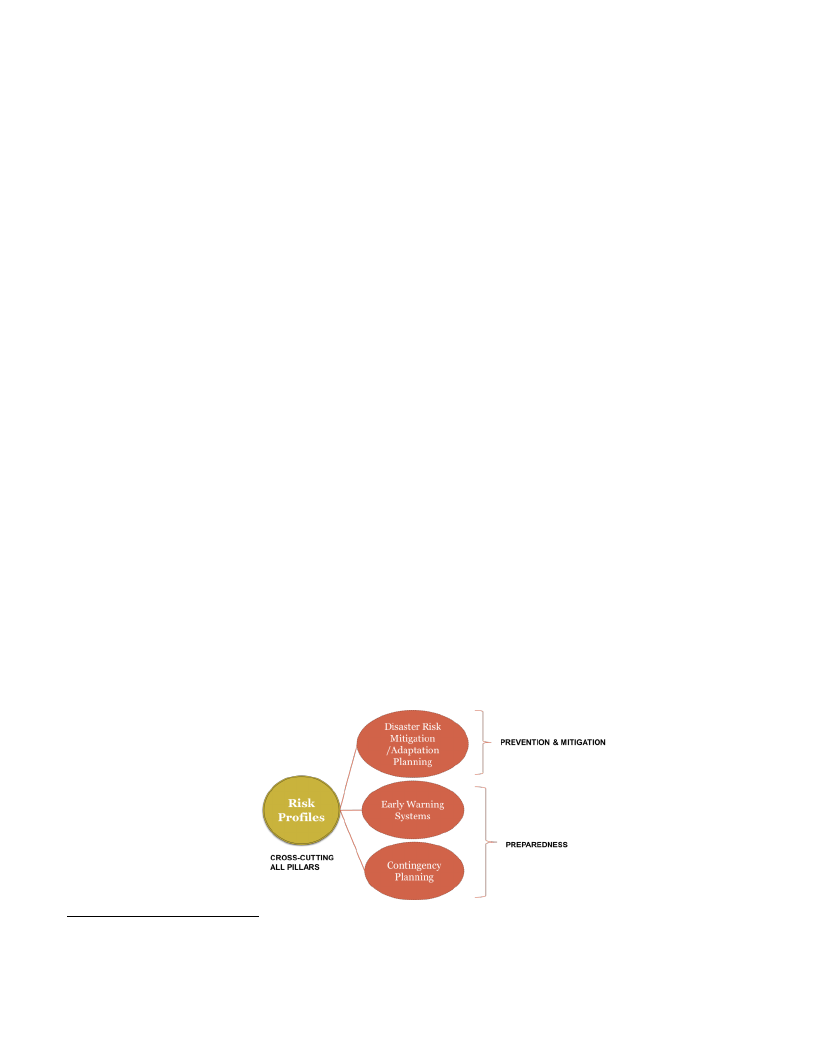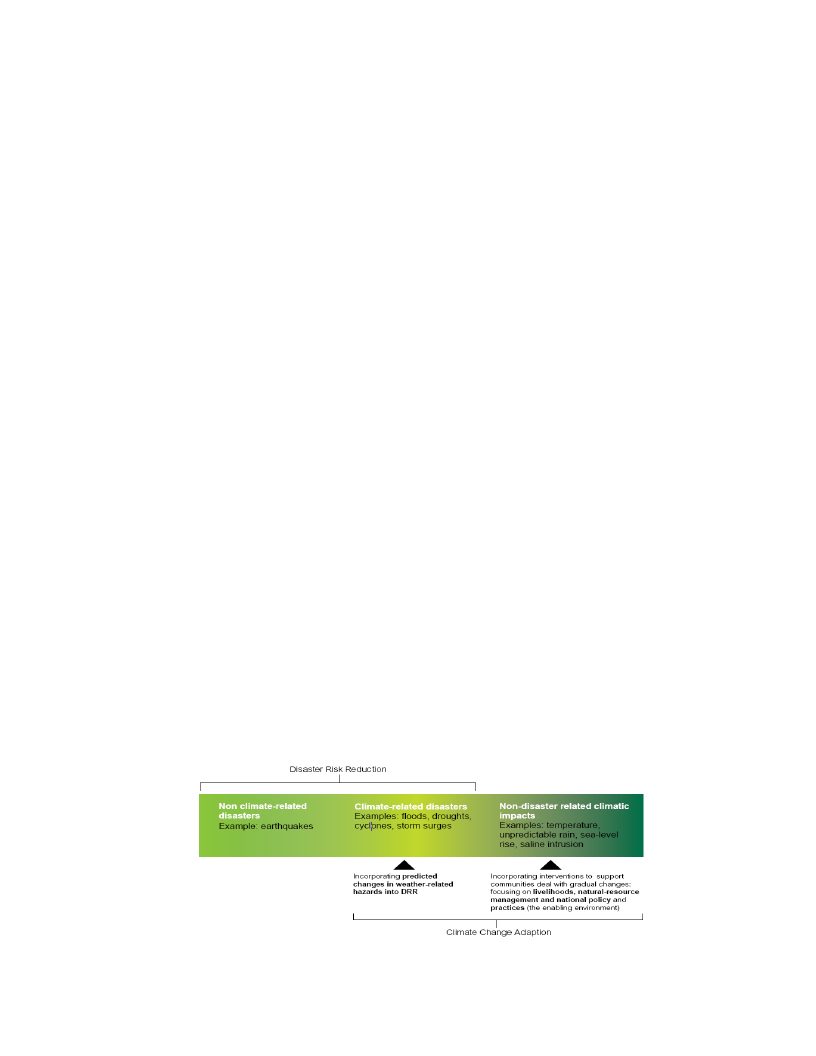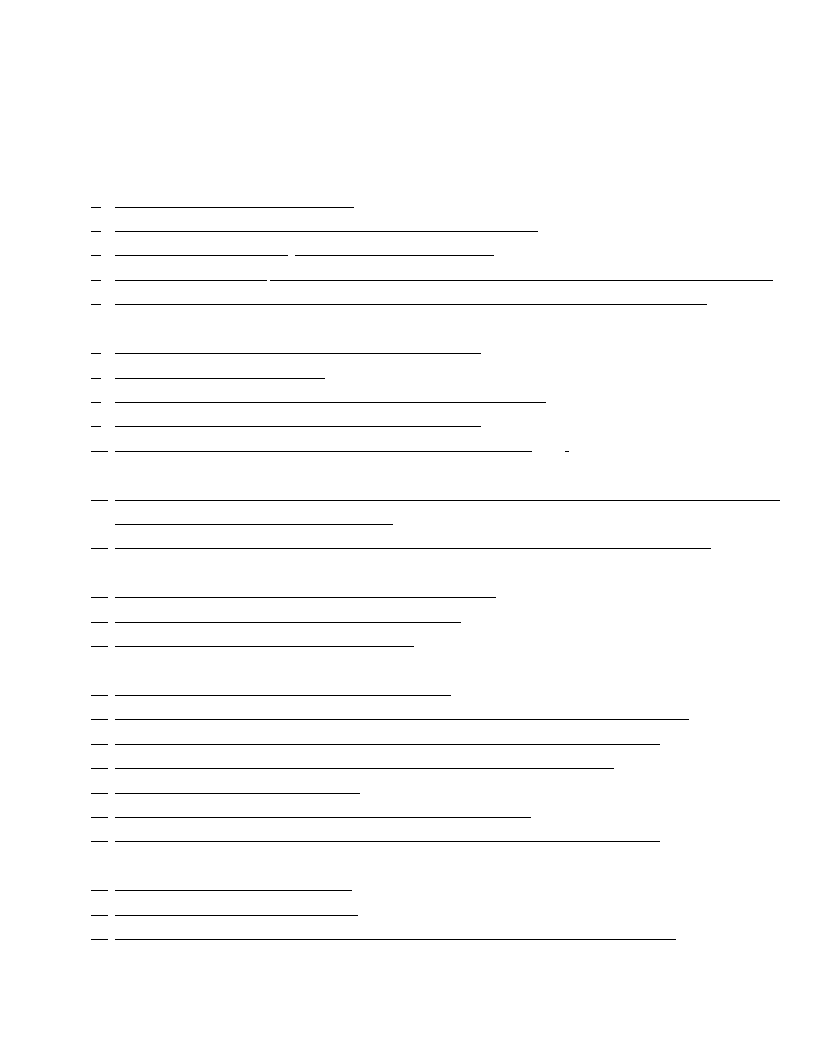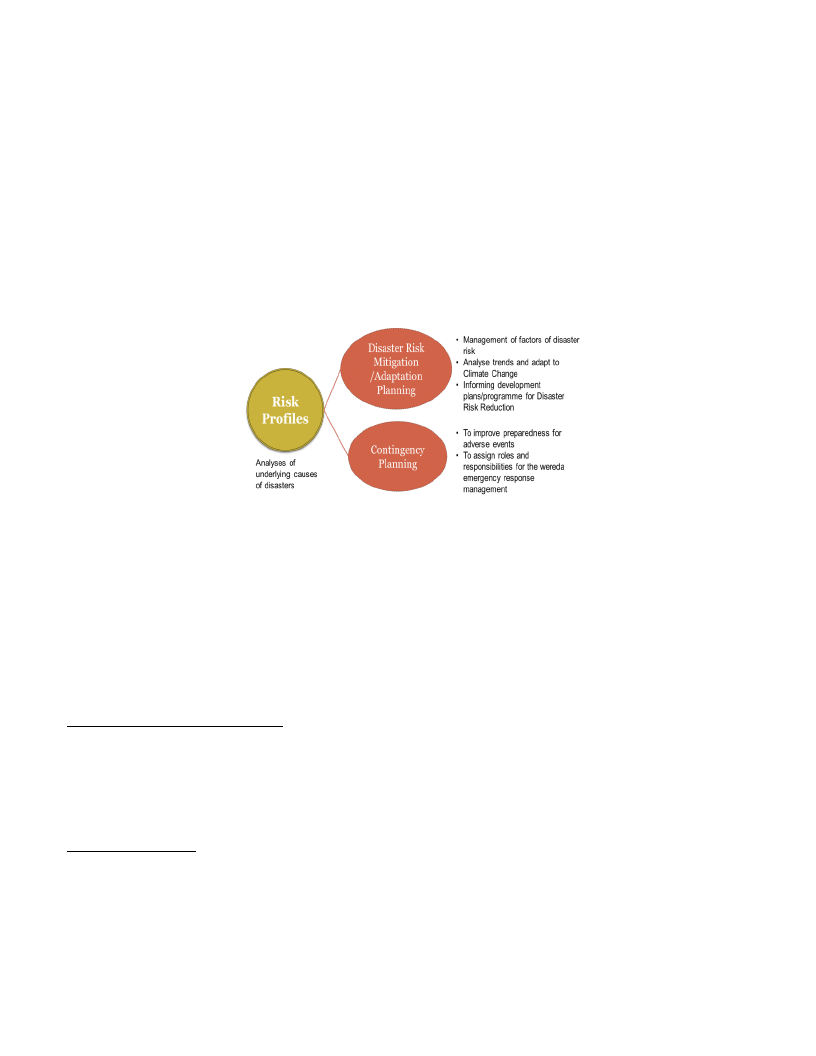
DRMFSS
WEREDA
DISASTER RISK
MITIGATION/ADAPTATION
PLANNING GUIDELINES
26/06/2013
1
*These guidelines are a living document

PREFACE
Ethiopia is exposed to a wide range of hazards associated with the country’s diverse geo-climatic and socio-economic
conditions. Ethiopia is well aware of the impact that disasters can have on the development goals that we are
rigorously pursuing through our Growth Transformation Plan. At the same time, these disasters can be exacerbated by
climate change which is changing the frequency and intensity of natural events increasing the vulnerability of
populations to hazards and it is likely to become more unpredictable in the coming years. With this recognition the
Government of Ethiopia started a paradigm shift a few years ago, largely triggered by the Government policies and the
Hyogo Framework for Action, shifting the focus from reactive crises management to a more proactive multi-sectoral
and multi-hazard Disaster Risk Management System.
With a view to operationalizing the revised National Policy and Strategy on disaster Risk Management, the government
of Ethiopia is designing and implementing different programmes with the Development partners. Some of them,
focusing on strengthening the capacities and resources at local level because the Ethiopia DRM systems shall be
decentralized and community-based whereby communities play decisive roles in the planning, execution, monitoring
and evaluation of DRM projects and programs.
To make the DRM programme implementation in the country well-informed, a comprehensive information
management system is required. That is why we are undertaking a comprehensive risk assessment exercise under
which Disaster Risk Profiles are being prepared for each district and at sub-district levels in the country. This Wereda
Disaster Risk Profile are based on local level information and establish an extensive database on disaster risk elements
and historical trends that will help decision makers at all levels to be better informed about nature, magnitude, and key
factors that renders people, livelihoods, environment and infrastructure vulnerable to disasters.
Such a comprehensive risk analyses system provides all the basic information which then feeds into Disaster Risk
Reduction and Climate Change Adaptation plans at district and community level and also to prepare comprehensive
multi-sector Contingency Plans.
It is a governmental responsibility that local development plans are adapted to the trends happening in the wereda
either produced by the climate change, demographics or other factors or also prevented of the negative effects of
disasters. Disaster Risk Mitigation and Adaptation Planning identifies the development strategies and activities that will
have higher impact reducing the disaster risk and adapting the communities to the localized trends, based on the
information provided by the Wereda Disaster Risk Profile and other secondary sources.
This manual gives the guidelines for planners to create a disaster risk mitigation and adaptation plan that will be used
by every sector and for the most important hazards present in the specific location. The users of the manual can be
government officials, executive bodies and associated stakeholders, community based organizations, private sector,
NGOs, UN organizations and donors working at wereda and kebele level.
The plan obtained by these guidelines should be specially used during the design of any development programme or
planning in order to mainstream in each sector or project the adequate actions for risk mitigation and adaptation.
I encourage all stakeholders involved at wereda level to use these guidelines and to participate, but also, to contribute
in the risk mitigation and adaptation planning process.
2

ACKNOWLEDGEMENTS
These guidelines have been initially based on the pilot experiences carried out by ACCRA Ethiopia (Africa Climate
Change Resilience Alliance) and the Bahir Dar University in 4 weredas and they have been developed and improved by
the support of World Food Program and leadership by DRMFSS. Also, the guidelines have been additionally
complemented with inputs from different International and national guidelines.
During the design process it has been incorporated ideas and comments of many people, although it would be difficult
to list them all by name, we would like to thank everyone who contributed.
Special acknowledgement is due to Charlotte Stemmer (ACCRA Ethiopia Lead), who has been contributing all process
and Dr. Wakjira Abdisa, who has been coordinating the logistics for the entire pilot exercises of the Wereda DRR
process.
We also thank ato Mathewos Hunde (Director of EWRD, DRMFSS) and Ato Tadesse Bekele (Deputy Director of EWRD,
DRMFSS), who steered the whole process. We are particularly grateful to the members of the Wereda DRR Steering
committee, Ato Negussie Kefeni (Head of EW case team), who chaired the steering committee and the rest of the
members, W/ro Beletu Tefera, W/ro Altayech Yitbarek, W/ro Beletu Tefera, ato Tarekegn Aga, ato Tsegaye Kelklie and
W/ro Almaz Demese. We also thank the support team of ACCRA team (Charlotte Stemmers, Kirsty Wilson, Mahteme
Mikre and Medhin Fissha) and the Bahir Dar University who have contributed to the development of this methodology.
We wish to thank everyone who took part in the background consultations and who gave feedback during the process.
We are particularly grateful for the assistance given by the wereda officers of Wuchale (Oromia) and Ewa (Afar), as well
as the staff of the DPPC of Oromia, and DPPB of Afar, who have contributed to the process supporting the pilot
exercises carried out in Wuchale and Ewa during July and August of 2012.
Finally, we are especially grateful to Animesh Kumar (DRM adviser of DRMFSS, seconded by World Food Program), who
initiated and supervised this process. This process would have not been possible without his coordination and support.
The document was designed, written and coordinated by Borja Santos Porras under a consultancy contract with WFP
Ethiopia during 2012 and 2013, in support of the DRMFSS.
Correct citation:
DRMFSS (2013), Wereda Disaster Risk Mitigation/Adaptation Planning Guidelines, Ministry of Agriculture (Disaster risk
Management and Food Security Sector), Addis Abeba, Ethiopia
For extra copies of the guidelines or addition information, contact:
Ministry of Agriculture, Disaster Risk Management and Food Security Sector, Addis Abeba, Ethiopia. Telephone: =251-
115-509666 Fax: +251-115-514788 E-mail: zinetahmed190@gmail.com
3

TABLE OF CONTENTS
PREFACE ................................................................................................................................................................................ 2
ACKNOWLEDGEMENTS......................................................................................................................................................... 3
Acronyms .......................................................................................................................................................................... 6
1. INTRODUCTION................................................................................................................................................................. 7
1.1. Purpose and Scope .................................................................................................................................................... 7
1.2. How to use these guidelines...................................................................................................................................... 8
1.3. Training materials ...................................................................................................................................................... 9
1.4. Objectives .................................................................................................................................................................. 9
2. KEY CONCEPTS ................................................................................................................................................................ 10
2.1. Understanding the planning environment .............................................................................................................. 10
2.1.1. International policies ........................................................................................................................................ 10
2.1.2. National Policies................................................................................................................................................ 11
2.1.3. National Strategies/Programs........................................................................................................................... 12
2.1.4. Linkages with other plans ................................................................................................................................. 14
2.2. Risk Mitigation and Adaptation concepts................................................................................................................ 16
2.2.1. Key concepts ..................................................................................................................................................... 16
2.2.2. Risk Mitigation and Adaptation integration ..................................................................................................... 18
2.2.3. Similarities and Differences .............................................................................................................................. 19
2.2.4. Planning principles............................................................................................................................................ 19
2.3. BOTTOM-UP Planning .............................................................................................................................................. 21
3. DISASTER RISK MITIGATION/ADAPTATION PLANNING PROCESS ................................................................................... 22
3.1. Form a planning team.............................................................................................................................................. 24
3.2. Risk Analysis ............................................................................................................................................................. 27
3.2.1. Concept ............................................................................................................................................................. 27
3.2.2. Methodology..................................................................................................................................................... 27
3.3. Strategy Identification and Prioritization ................................................................................................................ 32
3.3.1. Concept ............................................................................................................................................................. 32
3.3.2. Methodology..................................................................................................................................................... 33
4

3.4. Action planning ........................................................................................................................................................ 34
3.4.1. Concept ............................................................................................................................................................. 34
3.4.2. Methodology..................................................................................................................................................... 34
3.5. Mainstreaming, Monitoring and Updating .............................................................................................................. 36
3.5.1. Concept ............................................................................................................................................................. 36
3.5.2. Methodology..................................................................................................................................................... 36
3.5.2.1. Writing the plan, approve and disseminate the plan .................................................................................... 36
3.5.2.2. Mainstreaming............................................................................................................................................... 36
3.5.2.3. Monitoring ..................................................................................................................................................... 38
3.5.2.4. Updating ........................................................................................................................................................ 38
ANNEXES ............................................................................................................................................................................. 39
I. Glossary................................................................................................................................................................... 39
II. References .............................................................................................................................................................. 43
II. a. General literature about Risk Mitigation and Adaptation .................................................................................. 43
III. Terms of reference for the Wereda Disaster Risk Reduction Planning workshop (Risk Mitigation/Adaptation
plan and Contingency plan) ............................................................................................................................................ 45
IV. Examples for Risk Mitigation/Adaptation strategies and activities.................................................................... 50
IV. a. For dry land areas (pastoralist and agro pastoralist)......................................................................................... 51
TEMPLATES ......................................................................................................................................................................... 52
5

Acronyms
The following terms are used across the document and its comprehension will allow to have a common understanding
ACCRA
Africa Climate Change Resilience Alliance
CAF
Cancun Adaptation Framework
COP
Conference of the Parties
CP
Contingency Plan
CRGE
Climate resilient green economy
DRM
Disaster Risk Management
DRR
Disaster Risk Reduction
DRMFSS
Disaster Risk Management and Food Security Sector
EPA-CC
Ethiopian program of adaptation to climate change
EWS
Early Warning System
FSF
Fast Start Finance
GCF
Green Climate Fund
GoE
Government of Ethiopia
GTP
Growth and Transformation Plan
HIV/AIDS
Human immunodeficiency virus infection / acquired immunodeficiency syndrome
HFA
Hyogo Framework of Action
IPCC
Intergovernmental Panel on Climate Change
MoA
Ministry of Agriculture
NAPA
National Adaptation Program of Action
NGOs
Non-Governmental Organizations
NAMA
Nationally Appropriate Mitigation Action
NIMS
National Incident Management System
NMA
National Meteorological Association
PASDEP
Accelerated and Sustained Development to End Poverty
PCDP
Pastoral Community Development Project
PSNP
Productive Safety Net Program
RM&CCA
Risk Mitigation and Climate Change Adaptation
SPIF
Strategic Program Investment Framework
ToT
Training of Trainers
UN-ISDR
United Nations – International Strategy for Disaster Reduction
UNCED
United Nations Conference on Environment and Development
UNFCCC
United Nations Framework Convention on Climate Change
WDRP
Wereda Disaster Risk Profile
6

1. INTRODUCTION
1.1. Purpose and Scope
Ethiopia has registered steady and high economic growth in the last several years; however, being one of the most
disaster prone countries globally, the impact of disasters on rolling back the socio-economic gains cannot be
underestimated. Under such circumstances, an effective Disaster Risk Reduction planning becomes an important part
of the development planning in the country.
At the same time, these disasters can be exacerbated by climate change which is changing the frequency and intensity
of natural events increasing the vulnerability of populations to hazards and it is likely to become more unpredictable in
the coming years, with potentially major long-term challenges in future decades1.
Disaster Risk Reduction:
Ethiopia is likely to be one of the countries hardest hit by climate change. This
will impact all aspects of Ethiopia’s economy, potentially affecting the
Actions taken to reduce the risks of
disasters and the adverse impacts
of natural hazards, through
achievement of middle income and growth objectives, and with particularly
severe impacts for the agricultural, forestry, health, natural resources, water and
energy sectors.
systematic efforts to analyze and
manage the causes of disasters,
Disaster risk reduction and climate change are closely linked. Scientific evidence
including through avoidance of
hazards,
and
improved
preparedness for adverse events
shows that for disasters, climate change poses a double threat. Firstly, increases
are expected in the frequency and intensity of weather and climatic hazards, such
as floods, tropical cyclones, heat
UN/ISRD Definitions
waves and droughts. Secondly,
there are likely to be other
changes such as ecosystem
Climate Change:
degradation, reduced availability of water and food, and impacts on
livelihoods, which together will reduce the capacities of communities to
cope with natural hazards, especially in poor developing countries.
A change of climate which is
attributed directly or indirectly to
human activity that alters the
composition of the global
In this context, a key challenge and opportunity, therefore, lies in
building a bridge between current disaster risk reduction efforts, aimed
at reducing vulnerabilities to extreme events and efforts to promote
Climate Change Adaptation. This holistic concept is directly related with
atmosphere and which is in
addition to natural climate
variability observed over
comparable time periods.
building resilience at wereda level.
United Nations Framework Convention
on Climate Change (UNFCCC)
Under such circumstances, the government of Ethiopia inspired by the
Hyogo Framework of Action (HFA) and through Disaster Risk
Management and Food Security Sector (DRMFSS) has put in place
different programs which cover the different aspects of the Disaster Risk
Management. These programs are under the draft of the new DRM
National Policy which guides the shift from an emergency approach into
a development approach and establish that DRM should be
Climate change adaptation:
A change of the adjustment in
natural or human systems in
response to actual or expected
climatic stimuli or their effects,
which moderates harm or exploits
beneficial opportunities
1 Disaster Risk Management Strategic Program and Investment Framework
IPCC Climate Change Adaptation
Definition
7

decentralized and community based with a participatory approach. Also, Ethiopia’s ambition is to build a climate
resilient green economy (CRGE) that will protect Ethiopia against the negative impacts of climate variability, extreme
climate events, and long-term trends from climate change, ensuring the well-being of the people and the economic
growth and prospects of the country. These guidelines will contribute to these objectives developing a risk mitigation
and climate change adaptation at wereda level.
The first step has been to build a Wereda Disaster Risk Profile (WDRP) which establishes an extensive database at
community/kebele level and provide all necessary information on disaster risk elements. This information system
forms the basis for designing Disaster Risk Management strategies. Once the weredas and communities have
established their profiles and know the disaster risk elements the next step is to build the programs which forms the
full cycle of DRM (consisting of prevention, mitigation, preparedness, response, recovery and rehabilitation). Hence,
the Wereda Risk Mitigation/Adaptation Planning process will follow the principles to build resilience, where the
government will work with development and humanitarian partners to achieve synergetic results starting with
common analyses, the Wereda disaster Risk Profile
The planning process explained in these guidelines
focuses on the pre-disaster phase (see contiguous
figure) and it will cover specifically the mitigation and
prevention part. So, they will help planners at any
governmental level to improve the Risk Mitigation and
Adaptation Planning which covers any hazard and
sector at local level. The emphasis will not be to employ
new programmes and funds but to use the existing
budgetary mechanisms to have a more informed
development process in a Wereda. The Risk
Mitigation/Adaptation process works as an informed
‘Wereda Development Plan’ and all sectors and stakeholders are involved in the planning and implementation.
Disaster Management is a multi-sectorial responsibility and a coordinated effort by various institutions rather than
one agency responsibility, that’s why most of the sectorial institutions at wereda level will be included in the Disaster
Risk Reduction (DRR) Planning process.
1.2. How to use these guidelines
These guidelines are designed to help trainers and wereda staff involved in disaster risk mitigation/adaptation issues at
local level (wereda & community level) to tackle development plans analyzing the disaster risk including the Disaster
risk reduction approach. It also provides information and instructions on the fundamentals of Disaster Risk
Prevention/Mitigation, the climate change adaptation and their application.
Chapter 2 provides information about the DRR planning environment in Ethiopia and its principles and objectives. It will
help to contextualize the background and to understand the fundamentals of the process.
Chapter 3 explains the planning process and steps to build a Disaster Risk Mitigation/Adaptation Plan and describes the
Content Guide.
8

A detailed template is annexed with the formats required in order to standardize the information.
This process must be integrated in the development planning. This methodology will provide mechanisms that can be
used to mainstream this approach in the wereda development planning process.
1.3. Training materials
These guidelines will help readers to understand the process to build a disaster risk mitigation/adaptation plan but in
addition to these guidelines, presentations and others training materials have been prepared.
The training process will be cascaded from the federal level to the wereda and kebele level.
The Federal government will provide initial support though trainings, manual development and facilitation of resource
mobilization for doing the trainings.
In order to improve and to complement the results of the Risk Mitigation and Adaptation Planning, the process at
wereda level will include Contingency Planning. Hence, the planning process will cover main aspects of Disaster risk
reduction and it will help weredas to understand the process, the concepts and the similarities and differences.
According with the training material that has been prepared, the process is designed to cover 6 days, where
representatives from the Wereda sectorial offices, from the communities and wereda stakeholders will participate
actively in the planning process producing finally a Wereda Risk Mitigation and adaptation plan and a Contingency Plan.
1.4. Objectives
The main objective is to provide the wereda with the planning tool to enable them to develop a risk mitigation and
adaptation plan.
The specific objectives to achieve this aim are:
1. To introduce key concepts and planning process of Risk Mitigation and Adaptation planning
2. To collect the most important information of the Wereda Disaster Risk Profile and to analyze the hazards,
trends, vulnerabilities and capacities of the kebeles/wereda focusing on the information which help to
formulate disaster risk reduction interventions for the communities.
3. To build an action plan with strategies and activities which mitigate and prevent the disaster risk
4. To mainstream and follow up the Risk Mitigation/Adaptation strategies in the wereda sectorial development
plans
9

2. KEY CONCEPTS
2.1. Understanding the planning environment
2.1.1. International policies
Disaster Risk Reduction (DRR)
The Government of Ethiopia is highly committed to
the international Risk Reduction initiatives. Ethiopia
is one of the countries who pledged to implement
the Hyogo Framework for Action (HFA) which serves
as the primary international framework on DRR. It
was agreed in 2005 and its intended outcome for the
decade is “the substantial reduction of losses, in lives
and in the social, economic and environmental assets
of communities and countries”. It specifically
identifies the need to “promote the integration of
risk reduction associated with existing climate
variability and future climate change into strategies
for the reduction of disaster risk and adaptation to
climate change...”
Priority Action 4:
Reduce the underlying risk factors.
Disaster risks related to changing social,
economic, environmental conditions and land
use, and the impact of hazards associated
with geological events, weather, water,
climate variability and climate change are
addressed in sector development planning
and programmes as well as in post-disaster
situations.
Hyogo Framework for Action
The HFA offers five areas of priorities for action, guiding principles and practical means for achieving disaster
resilience for vulnerable communities in the context of sustainable development. The mitigation/adaptation
process seeks to achieve HFA Priority Areas 2 (Know the risks and take action) and 4 (Reduce the underlying
risk factors).
Climate Change Adaptation
The United Nations Framework Convention on Climate Change (UNFCCC) is an international
environmental treaty negotiated at the United Nations Conference on Environment and Development
(UNCED), informally known as the Earth Summit, in 1992. It sets an overall framework for intergovernmental
efforts to address climate change. It is called a framework convention because it is seen as a starting point of
addressing the problem of climate change. Ethiopia has ratified the UNFCCC (1994).
The Bali Action Plan, adopted at COP 13 in Bali, December 2007, identified adaptation as one of the key
building blocks required for a strengthened future response to climate change to enable the full, effective and
sustained implementation of the UNFCCC through long-term cooperative action, now, up to and beyond 2012.
At the Cancun Climate Change Conference in December 2010, Parties further established the Cancun
Adaptation Framework (CAF) with the objective of enhancing action on adaptation, including through
international cooperation and coherent consideration of matters relating to adaptation under the Convention.
10

Under the UNFCCC it is recognized that developing countries require international assistance to support
adaptation, including funding, technology transfer and capacity building. Parties in Cancun established
the Green Climate Fund (GCF) and decided that a significant share of new multilateral funding for adaptation
should flow through the GCF.
2.1.2. National Policies
2.1.2.1. Disaster Risk Management (DRM) policy
At the moment of writing these guidelines, the existing DRM policy is the ‘National Policy on Disaster
Prevention and Management’ signed in 1993. Although this policy was mainly focused on relief issues, it gives
importance to prevention among its objectives: “Disaster Prevention Programmes shall be given due emphasis
in all spheres of development endeavours”.
However, currently there is a draft of the new DRM policy called ‘National Policy and Strategy on Disaster
Risk Management’ in which is based the new DRM programs and the new Strategy Program and Investment
Framework for DRM in the country. In accordance with the new National Policy, Disaster risk Management
shall be a shared responsibility of the Government, civil society and humanitarian partners including NGOs,
private sector, voluntary organizations, community and individuals at all levels. For this reason, DRM should
be a process where all these actors participate to build resilience.
This Risk Mitigation and Adaptation Planning guideline will follow the guiding principles of the National Policy
on Disaster Risk Management (DRM).
• DRM is part of development - and is therefore the responsibility of all Sectors and Bureaus
• DRM should be de-centralised and community based
• DRM should take a participatory approach – consultation between all stakeholders is needed
• Accountability and responsibility are key to DRM – both downward and upward
• Managing information is vital for DRM – using the profile and the early warning system for decision
making, for example
• Impartiality is vital – the Government is responsible for meeting needs of people affected by disaster
equally.
• Relief efforts should be integrated with development to minimise dependency and promote recovery
• Due attention must be given to the most vulnerable groups (women, people living with HIV/AIDS, disabled
people and the elderly)
• DRM systems should be free from malpractice
2.1.2.2. Climate change related Policy:
The overarching policy that climate change currently sits under in Ethiopia is the Growth and Transformation
Plan (GTP) which directly addresses climate change and environment issues in a separate section. The GTP
stipulates the country’s ambition to build a climate resilient green economy by 2030 (see further information
in the Section 2.1.3.)
11

Climate change is also included in other policies, documents and plans2:
• The Environmental Policy (1997) aims to rectify the economic and social costs of environmental damage
from widespread mismanagement of environmental resources, and to provide overall guidance in the
conservation and sustainable utilization of the country’s environmental resources. The policy has
considered in its sectorial environmental policy components atmospheric pollution and climate change as
important environmental, social and development challenges that need to be tackled
• Plan for Accelerated and Sustained Development to End Poverty (PASDEP), which includes a national
strategy to enhance coping mechanisms regarding the adverse impacts of climate change, as well as other
relevant aspects, e.g. water harvesting and small scale irrigation.
• Agricultural Transformation Agency includes a program on environmental economics and climate change
which is being implemented with the support of ministry of agriculture and the research system (NARS)
• Environmental Policy
• Energy Policy and the Biofuels Strategy
• Agriculture and Rural Development Strategy
• Water Resources Management Policy, Strategy and Program
• Health Policy
• National Policy on Biodiversity Conservation
• The Pastoral Policy
• National Development Plan for Ethiopian Women, Children and Youth
2.1.3. National Strategies/Programs
2.1.3.1. Disaster Risk Management (DRM) Strategic Program Investment Framework (SPIF)
The DRM Strategic Programme and Investment Framework (SPIF) is a tool to implement different modalities of
the DRM policies whose main objectives is the establishment of a comprehensive and integrated Disaster Risk
Management system in the country. It covers all the phases of the Disaster Risk Management cycle
(Prevention, Mitigation, Preparedness, Response, Recovery and Rehabilitation).
The most important programs for these guidelines are part of these pillars:
2 ‘A Climate Change Country Assessment Report for Ethiopia’, Alebachew Adem and Woldeamlak Bewket
12

Program
Description
Wereda
Disaster Risk
Profile (WDRP)
The Wereda Disaster Risk Profiles (WDRP) will provide all necessary information on disaster
risk elements at wereda and sub-wereda (kebele) levels. Given that information for WDRP
has been collected at community and household levels any plan/program of the DRM cycle
developed based on WDRPs will address the problems faced at the community levels.
Contingency
Planning
Based on identified disasters risks by the Wereda Disaster Risk Profile, the contingency
plans will help to improve the response the emergency response management of the
administrative area.
Early Warning
System
The preparedness part of DRM cycle starts from an effective EWS. It will provide timely
information about the risk disaster situation in the wereda. The information is used: to
prevent, mitigate or respond forecasted disasters; to Trigger early action; and to update
possible scenarios of likely disaster.
Risk Mitigation To mainstream in the sectorial development plans those strategies and activities which
/ Adaptation reduce more the risk of the disaster in the wereda and that adapt to the changes produced
planning
by the climate change
2.1.3.2. Ethiopia's climate-Resilient Green Economy (CRGE)
Ethiopia is committed to building a climate-resilient green economy by 2025. Its plan to do so comprises
actions to reduce greenhouse gas emissions (“green economy”) as well as adaptation initiatives to reduce
vulnerability to the effects of climate change (“climate resilience”), all the while safeguarding economic
growth. The Climate Resilient Green Economy (CRGE) Initiative was launched in Addis Ababa in November 2011
to protect the country from the adverse effects of climate change and to build a green economy that will help
realize its ambition of reaching middle-income status by 2025. It also recognizes that traditional development –
through carbon intensification and environmental degradation is not sustainable. The climate-resilient green
economy will be able to withstand the shocks presented by a changing climate. Moreover, it will be delivered
through zero carbon growth (i.e. no increase in net emissions from today’s level). Realizing this vision will
require a coordinated and sustained effort by all parts of the Ethiopian society – the Government, civil society,
academia and the public.
The CRGE builds on the Growth and Transformation Plan (GTP), and is based on three complementary
objectives: fostering economic development and growth, ensuring mitigation of greenhouse gases (GHGs), and
supporting adaptation to climate change. The CRGE initiative will be comprised of two national strategies; the
Green Economy (GE) Strategy, which was launched in 2011, and the Climate Resilient (CR) Strategy, which is
currently being drafted. The GE strategy quantifies the opportunity presented to Ethiopia by green growth
across seven sectors of the economy. It identifies over sixty priorities for investment that will enable Ethiopia
to both grow its economy while minimizing emissions. The CR Strategy will identify the impacts and costs
posed by climate change and prioritize investments to reduce that vulnerability. In reviewing and compiling
adaptation options, the CR strategy will focus on priorities within agriculture, including disaster risk
13

management (DRM). This Risk Mitigation/Adaptation planning process should be linked in the future to the CR
strategy when this one will be defined.
Previously other initiatives have been developed like the National Adaptation Program of Action (NAPA) and
the Ethiopian program of adaptation to climate change (EPA-CC)
2.1.4. Linkages with other plans
The Disaster Risk mitigation/adaptation measures needs to integrated and coordinated with other development
planning mechanisms and programs. Due to that it should be linked with any development tool existing at the same
level.
2.1.4.1. Wereda Development Plans
The decentralization of the administrative resources is a key element of good development policies. In
Ethiopia, decentralization is a process on going in many aspects of the development. The new policies want to
give the Wereda Administrations the legal, institutional and financial bases for effective and efficient
administration and implementation of the development goals.
Nowadays, the wereda councils make budgetary decisions on block grants received from regional government,
as well as expenditure on its own revenues. For that purpose, Woredas are responsible of their local level
planning and budgeting. For the planning process the Woredas are dependent on other institutions below
them (Development Agents, Community Representatives…) for collection of information, identifying and
prioritization of development needs, and transferring this information to the Woredas.
The impacts of disasters and the climate change in the progress of the development goals at any level cannot
be underestimated, and they are expected to seriously and disproportionately affect the poorest people in the
communities. These people are especially vulnerable to disasters and climate change due to their heavy
reliance on climate-sensitive sectors such as rain-fed agriculture or the tendency to be located geographically
in more exposed or marginal areas. Poverty therefore increases exposure while also limiting the ability to cope
and adapt to climate change impacts which also affects all development sectors. Hence, wereda development
plans & programmes need to ensure that they are enhancing coping capacities of poor people as well as
enabling adaptation to future shocks and stresses, so mainstreaming or integrating disaster risk reduction and
climate change adaptation into wereda development planning process will increase the sustainability and
impact of interventions in every sector and specially in the most vulnerable community. Further details will be
found in the chapter 3, where the mainstreaming, monitoring and updating are explained.
2.1.4.2. Productive Safety Net Program (PSNP)
The Productive Safety Net Programme (PSNP) in Ethiopia was set up in 2005 by the government as part of a
strategy to address chronic food insecurity. The PSNP provides cash or food to people who have predictable
food needs in a way that enables them to improve their own livelihoods – and therefore become more resilient
to the effects of shocks in the future. The Productive Safety Net Program has been designed as an asset
protection mechanism for the household level and to create productive community assets.
The Objectives of PSNP are:
14

To provide households with enough income (cash/food) to meet their food gap and thereby protect
their household assets from depletion
To build community assets to contribute to addressing root causes of food insecurity.
The Risk Mitigation and Adaptation planning process will identify measures at kebele level which will affect the
disaster risk factors, decreasing the vulnerability and the impact of the hazards as well as increasing the
capacities and resilience. In this process, all actors in the wereda, including sectorial offices (including PSNP
focal point), kebele representatives and other stakeholders (NGO, UN, Private sector…), will participate in the
planning process and every actor will contribute with resources for the common actions and strategies
prioritized in the wereda.
The results of this identification can be used by PSNP to assign public works. Although PSNP will maintain
their identification procedures, their results can be cross checked with the ones identified by this disaster risk
mitigation/adaptation plan, taking them into account, in order to prioritize the actions with highest impact in
the Mitigation/Adaptation of the Disaster risks and to participate in the same outputs that have identified by
all actors of the wereda during the planning process.
2.1.4.3. Pastoralist Community Development Planning (PCDP)
The Federal Democratic Republic of Ethiopia (FDRE) mandated the Ministry of Federal Affairs (MoFA) to
coordinate and facilitate the Pastoralist Community Development Planning Program which ensures equitable
development in the pastoral and agro pastoral areas of the country based on the Government of Ethiopia's
policies of equitable and just distribution of resources. As a result the Ethiopian Government in collaboration
with the World Bank and the International Fund for Agricultural Development (IFAD) started implementing a
15-year Pastoral Community Development Program (PCDP) aiming at establishing effective models of public
service delivery, investment and disaster management in the arid and semi-arid Ethiopian lowlands that
address pastoral communities’ priority needs, improve their livelihoods, alleviate poverty and reduce their
vulnerability. Over a fifteen-year period, PCDP's interventions are designed to empower communities and
district (Wereda) and Regional governments (Somali, Afar, Oromia and SNNPR) to better manage local
development in pastoral areas, with the aim of increasing, stabilizing and diversifying incomes, improving
infrastructure and increasing access to public services. The second phase will finish in 2013, when the third
phase will start.
As well as the PSNP, the PCDP has their identification mechanisms to assign its budgets to different projects
and investments. However, the PCPD focal point will participate in the planning process for disaster risk
Mitigation/Adaptation so he can also cross check the result of the PCDP identification with the results of the
risk mitigation/adaptation plans and prioritize those actions which have been identified as the ones with
highest impact in the mitigation/adaptation of disaster risk in the wereda. Hence, the impact of the plan will
be strengthened if PCDP would participate in the same outputs identified by all actors of the wereda in the
disaster risk mitigation/adaptation planning process.
2.1.4.4. Growth Transformation Plan (GTP)
In 2010 Ethiopia unveiled the Growth and Transformational Plan (GTP) which sets the vision for the country as
a middle income, democratic and developmental state.
15

The GTP has a subsection on environment and climate change (subsection 8.9) which declares that Ethiopia
will pursue both climate change adaptation and considers Environment and Climate Change as one of the
cross-sectorial issues by identifying adaptation measures as key implementation strategies. Also, one of the
objectives of the GTP is ‘to improve disaster mitigation and managing’.
Success in delivering effective disaster risk management and climate change adaptation will then guarantee a
strengthened resiliency for the communities, substantial reduction in the underlying vulnerabilities and,
ultimately, the sustainability of economic and social development gains.
2.2. Risk Mitigation and Adaptation concepts
2.2.1. Key concepts
2.2.1.1. Disaster risk
The impact of disasters has been increasing, especially because the
increase in the population and other external factors. Rainfall deficit,
torrential rains, or earthquakes are natural phenomena but they are not
considered to be disaster in and of themselves. For example, if there is
an volcano eruption, but there is not population living around there will
be not people or property affected. This because, disaster cannot be
seen as a hazard, is a function of the risk process. It results from the
combination of hazard, vulnerability and capacity. The conditions of the
hazard (H) and vulnerability (V) contribute directly to the disaster risk,
the capacity (C) inversely (see next formula).
Disaster Risk= HxV/C
Hazard (H): A dangerous phenomenon,
substance, human activity or condition
that may cause loss of life, injury or other
health impacts, property damage, loss of
livelihoods and services, social and
economic disruption, or environmental
damage
Vulnerability (V): The characteristics and
circumstances of a community, system or
asset that make it susceptible to the
damaging effects of a hazard.
Capacity (C): The combination of all the
strengths, attributes and resources
available within a community, society or
organization that can be used to achieve
agreed goals.
Hence, to reduce the disaster risk, it will be necessary after the analysis
UN-ISDR Terminology
of the factors, to reduce as
Prevention: The avoidance of adverse
impacts of hazards and related disasters
taken actions in advance
possible the conditions of the
hazard and vulnerability, and to increase the capacity. The final strategies and
actions that will be identified in this planning process, will try to mitigate and
Mitigation: The lessening or limitation
of the adverse impacts of hazards and
related disasters.
UN-ISDR Terminology
prevent the disaster risk trough those conditions.
The Disaster risk Management Cycle shows a process to address the specific
issues or disaster risk.
The risk Mitigation and Adaptation process will work in the pre-disaster phase,
before the disaster could happen, being part of the Prevention and Mitigation
phase (see definitions in the contiguous box).
16

2.2.1.2. Climate Change Adaptation
Weather is the set of meteorological conditions – wind, rain, snow, sunshine, temperature, etc. – at a particular time
and place. By contrast, the term climate describes the overall long-term characteristics of the weather experienced at a
place.
The climate therefore can be thought of as a long-term summary of weather conditions, taking account of the average
conditions as well as the variability of these conditions. The fluctuations that occur from year to year, and the statistics
of extreme conditions such as severe storms or unusually hot seasons, are part of the climatic variability. Some slowly
changing climatic phenomena can last for whole seasons or even years; the best known of these is the El Niño
phenomenon. Because the climate system is in a constant state of flux and has always exhibited natural fluctuations
and extreme conditions, it is not possible to argue that any single extreme event is attributable to climate change. Only
after a sufficient period and with hundreds of extreme events recorded can scientists determine if a specific event is
within normal historical variation or is due to some other cause such as climate change.
Africa is particularly vulnerable to the effects of climate
change because of multiple stresses. Drought will continue to
be a primary concern for many African populations. The
frequency of weather- and climate-related disasters has
increased since the 1970s, and the Sahel and Southern Africa
have become drier during the twentieth century. Water
supplies and agricultural production will become even more
severely diminished. By 2020, in some African countries
agricultural yields could be reduced by as much as 50%. By
the 2080s, the area of arid and semiarid land in Africa will
likely increase by 5-8. A range of studies of national climate
trends in Ethiopia since the 1960’s show that mean
temperatures have increased by 0.5 and 1.3 C3. Rainfall
estimates are much more uncertain, with no significant
change in total rainfall amount, but with changing seasonal
patterns4 and more rain falling in extreme events5.
Natural hazards by themselves do not cause disasters – it is
the combination of an exposed, vulnerable and ill prepared
population or community with a hazard event that results in a
disaster. Climate change will therefore affect disaster risks in
two ways, firstly through the likely increase in weather and
climate hazards, and secondly through increases in the
Agriculture is particularly sensitive to climate change.
Greater total or more intense rainfall across Ethiopia
may increase soil erosion and the incidences of crop
damage. Ethiopia is particularly vulnerable to
accelerated soil erosion because of existing pressures
and degradation on our land area, 79% of which has a
slope of greater than 16%, with 25% having a slope of
greater than 30%. There will also be changes in
production system viability; cropland area and
cropping patterns; pest and disease frequency and
distribution brought about by changes in seasonality;
timing and distribution of rainfall; higher
evapotranspiration; drought and flood damage.
Livestock yields will be impacted directly through
temperature effects on annual growth, milk and wool
production and reproduction; and indirectly by
changes in the quantity and quality of pasture, forage,
grass and disease and increases in parasites. Pastoralist
communities may be particularly negatively impacted
by climate change. The interactions between these
problems and potential benefits of greater CO2
‘fertilization’ are largely unknown.
Climate Resilient Green Economy strategy
(Ethiopia)
3 McSweeney, C., New, M. and Lixcano, G., (2007) Ethiopia – UNDP Climate Change Country Profiles report a 1.3°C increase between 1960 and 2006. Other studies
show a smaller increase, for example: Conway et al report rises of approximately 0.5°C from 1961-2000, in Conway, D. and Schipper, E. L. F. (2011) Adaptation to climate change in
Africa: Challenges and opportunities identified from Ethiopia. Global Environmental Change 21 (2011), 227–237. Also in the National Adaptation Programme of Action, 2007, the
National Meteorological Agency reports increases of 0.37 0C every 10 years from 1951-2006.
4 Conway, D., Schipper, E. L. F., Mahmud, Yesuf, Menale, Kassie, Persechino, A., and Bereket Kebede. (2007) Reducing Vulnerability in Ethiopia: Addressing the Implications of
Climate Change. Report prepared for DFID and CIDA. University of East Anglia, Norwich.
5 McSweeney et al, 2007, ibid; and Ericksen P, Thornton P, Notenbaert, A, Cramer L, Jones P, Herrero, M. (2011) Mapping hotspots of climate change and food insecurity in the
global tropics. CCAFS Report No. 5 (advance copy). CGIAR Research Program on Climate Change, Agriculture and Food Security (CCAFS). Copenhagen, Denmark. Available online
at: www.ccafs.cgiar.org.
17

vulnerability of communities to natural hazards, particularly through ecosystem degradation, reductions in water and
food availability, and changes to livelihoods. Climate change will add yet another stress to those of environmental
degradation and rapid unplanned urban growth, further reducing communities’ abilities to cope with even the existing
levels of weather hazards. The poorest communities are the most vulnerable to climate extremes, the impacts of
which will increase with the changing climate. Poor women and men should be at the center of the response to climate
change.
2.2.2. Risk Mitigation and Adaptation integration
The expressions “disaster risk reduction” and “climate change adaptation” represent policy goals, one concerned with
an ongoing problem (disasters) and the other with an emerging issue (climate change). While these concerns have
different origins, they overlap a great deal through the common factor of weather and climate and the similar tools
used to monitor, analyze and address adverse consequences. It is important, therefore, to consider them and
implement them in a systematic and integrated manner.
A key challenge and opportunity, therefore, lies in building a bridge between current disaster risk reduction efforts,
aimed at reducing vulnerabilities to extreme events and efforts to promote Climate Change Adaptation.
There are several arguments about the key benefits of the integration between them, such as how the disaster Risk
mitigation and prevention measures can reduce climate related losses; the importance of increasing efficiency of
resource allocation through this integration; and how it will enhance the effectiveness and sustainability of both
approaches. The most important similarities are that both are multivariable process that involves incremental changes
in biophysical variables and processes, as well as, extreme events. Furthermore, Climate Change also affects societies’
and communities’ vulnerability to hazards, through changes in inherent dynamics. Therefore, from a disaster risk
reduction perspective, Climate Change affects both, hazards and vulnerability. Nevertheless, the examination of the
similarities between adaptation and disaster risk reduction also highlights differences. One of the most obvious
distinctions is that disaster risk reduction addresses all types of hazards, including geological hazards, while climate
change adaptation is only focused on the dynamics of climate. Moreover, disaster activities still focus more on reducing
immediate causes of hazard and impact, while, for adaptation, the current interventions are often more focused on
reducing only impacts of Climate Change without a holistic view of what actually causes risks .
The following diagram shows the relationship between Risk Mitigation and Climate Change Adaptation:
Relationship between RM and CCA
18

In conclusion, in both cases a change in mindset is still necessary to direct interventions to reducing underlying
vulnerability and addressing root causes, ensuring a long-term sustainable perspective.
Lack of integration between RM & CCA might result in:
Continued growth in disaster risk associated to climate change
Increased administration burdens, prevent efficient use of resources in reducing risk
Unsustainable RM resulting in mal-adaptation (i.e. DRR based on past & current experiences is likely to fail in
its aim of building people’s resilience to future risks if it does not account for, & address, the consequences of
climate change)
2.2.3. Similarities and Differences
SIMILARITIES
DIFFERENCES
Both have similar aims: reducing people’s vulnerability Hazard type: Disaster risk Reduction addresses all
& building resilience to hazards in the context of types of hazards; Climate Change Adaptation addresses
sustainable development
only hydro-meteorological hazards
Mutual benefits: Disaster risk reduction supports
Climate change adaptation through reducing climate
related disaster risk & in offsetting the long term
implication of climate change
Poverty reduction: both addresses the issue of poverty
through reducing underlying risk & both recognize ‘the
poor’ as the most vulnerable
Converging political agenda: governments have come
to recognize that risk reduction associated to climate
change should be incorporated into development
strategies
Time scale: DRR concerned with the present & near
future; CCA concerned with the short, medium & long
term future
Level of significance placed on existing capacities: DRR
focuses on traditional knowledge & Past experiences in
reducing disaster risk; CCA focus more on science &
innovation in addressing future risks associated with
climate change
2.2.4. Planning principles
- Disaster risk Mitigation/Adaptation Planning must include participation from all stakeholders. Effective planning
ensures that the community is represented and involved in the planning process. Disasters and climate change
affect all of society, and therefore Risk Mitigation and adaptation solutions must involve all sectors. The most
realistic and complete plans are prepared by a diverse planning team, including representatives from the different
sectorial offices, civic society, partners and community representatives who are able to contribute critical
perspectives and/or have a role in executing the plan. There are obviously many advantages of inter-sectorial
collaboration, these being: looking for the same impacts, minimizes duplication of activities; facilitates sharing of
experiences; promotes team spirit; minimize time waste; and, maximizes optimal use of scarce resources. Also the
new national policy advocate for mainstreaming Disaster Risk Reduction in all sectors at all levels.
- Disaster risk Mitigation/Adaptation Planning includes decision makers throughout the process to ensure both
understanding and approval. Potential planning team members have many day-to-day concerns but must be
reminded that Risk Mitigation and Climate Change Adaptation planning is a high priority. The more involved
decision makers are in planning, the better the planning product will be.
19

- Disaster risk Mitigation/Adaptation Planning must represent the whole population and its needs. It is very
important to recognize that different people has different perceptions of risk and different understanding and
experience in coping with it. Understanding the composition of the population—such as accounting for people with
disabilities, others with access and functional needs, for elder people needs, for gender issues and for the needs of
children—must occur from the beginning of the planning effort.
- Women have unique needs in disaster situations and specific vulnerabilities against disaster risk. It has to be
addressed, but they also have unique capacities that must be taken into account in community-based disaster risk
reduction and in climate change adaptation planning. Men and women may have different understandings and
experience in coping with risks. Women participation is very important during the planning process.
- Disaster risk Mitigation/Adaptation Planning must be community-based and include local knowledge. Natural
disasters and the Climate Change effects frequently vary significantly by micro regions. Hence, local knowledge
(indigenous knowledge) must be integrated with scientific evidences in order to design and implement effective
disaster risk management and climate change adaptation strategies. In other words, the role of community should
be considered a key for disaster risk management and climate change adaptation strategies to be successful. It will
also help to decentralize the RM&CCA processes.
- Disaster risk Mitigation/Adaptation planning should be practical and realistic. It should be based on realistic
parameters and resources, and should not be a bureaucratic exercise. Apart of creating awareness and knowledge
among the participants, this methodology should really improve the impact of the development plans reducing the
risk disaster and improving the adaptation to the Climate Change
- Disaster risk Mitigation/Adaptation Planning should be simple and easy to do. RM&CCA planning should not be a
complex task undertaken only by specialists; rather, all staff – and indeed community representatives – should be
able to participate.
- Disaster risk Mitigation/Adaptation planning considers all hazards and threats. There are ongoing some existing
programs in Ethiopia for DRR, however, they are usually focused on one hazard: mainly drought or flood. This
program at Wereda level will consider all hazards and threats and it will prioritize those who have more impact and
considered more important by the community (indicated in the Wereda Disaster Risk Profile)
- Disaster risk Mitigation/Adaptation planning allocates possible sources resources to accomplish those tasks
identified, and it establishes accountability. Decision makers must ensure that they provide planners with clearly
established priorities and feasible resources; additionally, participants should be held accountable for effective
planning and execution.
- Disaster Risk Mitigation/Adaptation planning outputs must be followed up. Strategies and activities should be
monitored to assure the impact.
- Disaster Risk Mitigation/Adaptation planning must have a human rights approach. It is now widely recognized
that effective poverty reduction is not possible without empowerment of the poor. The human rights approach to
poverty reduction is essentially about such empowerment. This recognition of the existence of legal entitlements
of the poor and legal obligations of others towards them is the first step towards empowerment. A human rights
approach to poverty reduction requires active and informed participation in the formulation, implementation and
monitoring of poverty reduction strategies.
20

2.3. BOTTOM-UP Planning
The bottom-up planning is an approach where plans are developed at the lowest level. The Risk Mitigation and
Adaptation will follow the bottom-up planning. Firstly, when the information collected from the Wereda Disaster risk
Profile comes from households and key informants from the community, and secondly, when both kebele
representatives and sectorial offices identify and prioritize strategies and actions to mitigate disaster risk and to adapt
to the climate change in the wereda. The Bottom-up planning has the next characteristics:
Communities have experiences, skills and resources at hand to solve some of their problems
Bottom up planning help to reduce the gap persisted between real community needs/demands and the
availability of resources to meet the community needs.
Bottom up planning empower the community members giving ownership in the development process instead
of giving individual responsibilities for development to experts or outsiders or agencies from outside.
Bottom up planning help the community to have more presence in the resources allocation decisions. E.g,
resources always held outside the kebele
Community-based processes helps in building confidence, pride in being able to make a difference, and
enhanced capabilities to pursue DRM and CCA measures
Bottom up planning should anticipate the possible problems of decentralization in regards to how to bring
together the high level strategic thinking and the local level context, in a way that ensures the optimization of
outcomes. It is generally known that decentralization has several risks: elite capture (local elites capturing the
benefits); revenue minimization (low capacity and unwillingness to mobilize local resources); weak
administrative and management systems (absence of effective and efficient administrative and management
systems); corruption (political influence and risk for corruption); lack of effective participation (no automatic
increase in participation); and, poor human resource base (staff unwilling to move to remote areas, and poorly
trained or motivated).
Outsiders can bring new knowledge, resources and skills to a community BUT communities should be the one
to determine whether it adds value for them
21

3. DISASTER RISK MITIGATION/ADAPTATION PLANNING PROCESS
Disaster Risk Mitigation/Adaptation planning can also be considered as an approach that aims to reduce disaster risk
through the application of participatory assessment and bottom-up planning methods. It is a practical bridging strategy
to integrate local development efforts on one hand with strategies and actions that reduce the impact of priority
disaster & climate risks on the other. Risk Mitigation/Adaptation aims to reduce vulnerabilities and strengthen
people’s capacities to manage specific disaster & climate risks, even if it is not possible to address all their day-to-day
difficulties.
This process applies at all levels of government and allows private and nongovernmental organizations to integrate
with government planning efforts.
The development of Risk Mitigation & Climate Change Adaptation planning can be described briefly by the following
steps:
1. Form a planning team
It is very important to establish a collaborative planning team that includes experts from different sectors
who get a better understanding of the disaster risk factors and identify and follow-up possible prevention
and mitigation measures that will be mainstreamed in the sectorial development plans. It will be very
helpful if that planning team is already a structure, platform or committee already established in the
Wereda, because the planning results can be integrated in the terms of reference and the follow up
mechanisms of that planning team.
Although individual planners can use this process, it is most effective when it is done by a planning team.
2. Disaster Risk analysis
It involves collection and analyses of information regarding all important hazards that have the potential to
become a disaster. The Wereda Disaster Risk Profiling (WDRP) database provides information about
hazards and associated trends, vulnerability factors, and existing and required adaptive capacities of
communities. Therefore these profiles will be used to analyze disaster risk at wereda and kebele levels and
inform the process. This information will determine the type of strategies that are needed to reduce the
risk.
3. Strategy identification & prioritization
A wide range of strategies will be identified to reduce the risks. However, since resources are limited to
implement all of identified strategies, participants shall rank and prioritize those according different factors
in order to select the better strategies to address the risks.
4. Action planning
Every Sectorial Office prepares an action plan, focused on defining selected strategies as objectives and
specifying a list of activities to implement identified strategies.
5. Mainstreaming and follow up
22

The planning results shall be mainstreamed in the development planning mechanisms and if possible,
followed up with similar mechanisms. Mainstreaming and follow up is an absolutely necessary step, in
order not to become the results in one more document in the shelves.
Typically, time is a constraint for developing the plan so initial steps can be minimized in order to accelerate the
process, however the action planning and mainstreaming and follow-up should be always well completed and well
carried out.
The following figure shows the structure of these planning steps.
Form a planning team
Organize a planning team/ structure
Risk
Analysis
What disaster
risk elements
exist?
Strategy Id &
Prioritization
Which
strategies to
address the
risks should be
planned for?
Action
planning
What activities,
responsible and
timelines will be
defined to
mitigate the
risks?
Mainstreaming
and follow up
Integrating into
the development
plans and
monitoring
23

3.1. Form a planning team
The effects of the disaster have significant consequences for the development of all sectors in the wereda. Hence it will
be necessary the presence of experts of different sectors to plan how to avoid or to reduce the adverse impact of the
hazards.
Also, another goal of using a planning team is to build a common understanding of the risk analysis of the wereda and
expand relationships that bring collaboration and confidence to plan together.
Some tips for gathering the team together include the following:
Plan ahead. The planning team should receive plenty of notice about where and when the planning meeting
will be held.
Provide information about team expectations. Planners should explain why participating on the planning
team is important to the participants’ offices/organizations and to the community itself, showing the
participants how their contributions will lead to more effective planning.
Ask the senior elected, appointed official or highest authority to sign the meeting announcement. An official
letter from the executive office carries the authority of the senior official and sends a clear signal that the all
relevant participants are expected to attend and that operational planning is important to the community.
Consider using external facilitators. Third-party facilitators can perform a vital function by keeping the process
focused and mediating disagreements.
As a consequence of these tips, when the
corresponding administration level will send an
official letter to prepare the planning workshop,
a paper sheet will be attached where it will be
possible to find the Term of References of the
planning process. This will contain information
about the objectives, the necessary participants
for the workshop and the necessary duties that
would be needed before it. An example of Term
of Reference is added in the Annex IV.
The key to plan in a group setting is to allow
open and frank discussion during the process.
Interaction among planners can help elicit a
common understanding. Individual group
members must be encouraged to express
objections or doubts. If a planner disagrees with a
suggested intervention, that planner must also
identify how this can be improved.
Information in advance
It is important to collect in advance the most important information
which can help the effort of the planning process:
The Wereda Disaster Risk Profile will provide with the most
extensive database made at community/kebele level existing in the
country. The information system forms the basis for designing
long-term risk reduction/development programs at wereda and
sub-wereda levels.
The Wereda sectorial Development Plans will be fundamental in
order to see how to mainstream the results of the planning
process. Risk Mitigation and Adaptation action plans should be
integrated into the Wereda Development Planning mechanism, so
any information regarding with that (budgets, existing plans…)
should be collected in advance
Finally, others existing programs plans such as PSNP, PCDP… will be
interesting in order to work in common with similar strategies and
activities.
24

Involvement of all relevant DRM stakeholders will be important. Senior
managers and decision-makers should lead Risk Mitigation and Climate
Change Adaptation planning processes to give the relevant support to the
reduction of the adverse impacts of the disaster in the wereda. The
planners must ensure that planning process involves all actors who work in
the administrative area in issues related with the Risk Mitigation and
Adaptation.
Disaster Risk Management shall be
everyone’s responsibility: government,
communities, private sector, civil society
and development and humanitarian
institutions.
Initially, the team should be relatively small, consisting of more relevant planners from the ministries/bureaus/offices
and other organizations (including community organizations) that usually participate in Disaster Risk Reduction. They
form the core for all planning efforts. At local level, all the participants will sign the approval document that will certify
the validation of the Disaster Risk Mitigation and Adaptaion plan so this is other reason why all these participants must
be involved during the Contingency process.
Governmental environment
Every sector/office which can have relation with the
impact of adverse disaster should have a representative
in the planning team. The Directives for the
Implementation of the new National Policy on Disaster
Risk Management (DRM) establishes the members
involved in the federal DRM Council. Similar members
could be included in the planning process. Wereda
structure is explained in the adjoining box.6
A proposal of governmental necessary participants is in
the annex 4 with the Term of Reference of the Wereda
workshop.
Wereda Structure
The structures of most Woredas reflect the
institutional setup of regional governments as
regards sectoral competencies, integration and
coordination. The Woreda executive consists of
technical heads of all offices and a political Woreda
Administrator (who is elected by the council and
heads the Woreda executive). The Woreda Council,
which comprises of elected representatives from
each Kebele, is responsible for the final approval of
plans. Woredas are responsible for consolidating
priorities and reconciling them to match with
available financial resources.
International Organizations, Non-Governmental Organizations (NGOS) and scientific agencies/organizations
These actors can support the governmental institutions with specific projects. Initially many actors make their
own identification of the problems in order to design the projects. The current idea is that the Wereda Disaster
risk Profile will provide the baseline of the risk analysis and
during this common process, all actors will design in common
the best strategies and activities to reduce the disaster risk
and to adapt to trends produced by climate change,
providing with resources and working all together in the
same planning outputs in the wereda.
Although currently in Ethiopia, the external
stakeholders (NGOs, UN…) make the official
agreements at regional level, in those agreements
they could include those strategies and actions
which have been identified jointly during the
Disaster Risk Mitigation and Adaptation planning
process.
Community involvement
Community should have a say in how disaster response occurs and should take responsibility for protecting
themselves of the impacts of disasters and thanks to their knowledge and expertise, the strategies selected will
address better the root causes of risk. They should also shoulder responsibility for building their community’s
6 ‘Training Guide for: Training of Trainers on Integrated Community Based Participatory Planning’
25

resilience and enhancing its recovery before, during, and after a disaster. Due to that, Disaster Risk Mitigation
is most effective at community level where specific local needs can be met. Hence, Community leaders have a
keen understanding about their community’s needs and capabilities and are valuable stakeholders that can
support the planning process..
Additional participants can be considered if the wereda administration office considers it appropriately.
Finally, these questions in the following box will help us to check that the planning team is well organized and
represented.
Planning Team Checklist
Are all sectors covered?
Are all sectors well represented?
Are community-based organizations or groups that are familiar with the local situation
represented?
Are all mandated organizations represented?
Are NGO, donors and multilateral organizations operating in the Woreda represented?
Are communities from each kebele or Livelihood zone represented?
Are the representatives committed and dedicated?
26

3.2. Risk Analysis
3.2.1. Concept
According to the UN-ISDR, it can be defined as: ”Risk assessments include: a review of the technical characteristics of
hazards such as their location, intensity, frequency and probability; the analysis of exposure and vulnerability including
the physical social, health, economic and environmental dimensions; and the evaluation of the effectiveness of
prevailing and alternative coping capacities in respect to likely risk scenarios. This series of activities is sometimes
known as a risk analysis process”.
Hence disaster risk analysis can be seen as a function of hazards, vulnerability
and capacity. However, as we have seen in the chapter 1 and 2, disasters can be
Disaster Risk= HxV/C
exacerbated by climate change which is changing the frequency and intensity of
natural events increasing the vulnerability of populations to hazards. In this context, holistic management of disaster
risk requires action to reduce impacts of extreme events before, during and after they occur, including technical
preventive measures and aspects of socio-economic development designed to reduce human vulnerability to hazards.
Hence Risk Mitigation and climate change adaptation shall be closely linked.
Due to that, the risk analysis will also analyze the trends in physical, social and political environment in which they live
and the capacity will be analyzed not only in terms of the capacity to manage the risk associated with extreme events/
hazards but also in terms of the adaptive capacity to adapt to longer-term trends and stresses.
All the information analyzed during this process has the purpose to serve to the sectorial planners to be able to identify
the best strategies which can contribute to reduce and prevent the disaster risk. It is important that the experts of the
different sectorial offices have in common the same risk analysis of the territory in order to plan with the same
baseline and same conception of the common problems.
3.2.2. Methodology
Ethiopia has great spatial disparities in terms of occurrence of disasters –
not all parts of the country suffer from the same type of disasters.
Therefore, it is necessary to obtain information risk analysis at kebele
level and to prepare, from the bottom up, Disaster Risk Mitigation and
Adaptation plan involving the community and all the kebeles.
The Wereda Disaster Risk Profiling (WDRP) database will give the most
relevant information of the risk analysis at kebele and wereda levels. It
provides extensive and comprehensive information about the nature,
magnitude and key factors that render people, livelihoods, environment,
political systems and infrastructure vulnerable to disasters. Most of this
information will be used during the planning process, however for the
Risk Analysis which will be shown in the document; it will present only
that information that will be indispensable to ensure better disaster risk
Sample hazards list
Droughts
Floods
Landslides
Crop diseases
Livestock diseases
Human diseases
Storms / Cyclone/hail storm
Heavy rain
Frost / Cold waves
Heat waves/ High temp
Conflicts
Economic / Price shock
Forest fires
Earthquake
Road Accident
Source:Wereda Disaster Risk Profile
27

mitigation/ adaptation to a likely disaster. For that purpose, the more important aspect of the risk information will be
organized in the right format that can be usable by the planning team in order to identify the most adequate
interventions.
Once the Risk Analysis is done, mapping is very important to show those localizations with higher probability of being
affected.
This planning process will cover any hazard, caused by natural or technological factors or human-caused. Apart from
this list shown in the table there is always a potential for new and unexpected risks. This list may give the impression
that hazards are independent of one to another, but in fact they are often related.
Finally, it can be important to know, once the risks have been analyzed, the existing interventions (by governmental
institutions or by external stakeholders) done in the past for Disaster Risk Mitigation and Adaptation… All the lessons
learned obtained from this analysis, will be very useful to improve the plan that the administration is preparing.
The WDRP will provide most of the information needed for this steps and during the workshop, the data will be
validated and modified in case that it can be needed.
The templates of these steps can be seen at the end of these guidelines, as part of the Annexes. So, it is advisable to
read the following sections at the same time than the templates.
3.2.2.1. Hazard mapping
A hazard map allows the reader to observe the location of the most serious likely disasters. In rural areas,
where sometimes there are not appropriate maps of the territory or when the technologies or capacities do
not allow production of accurate maps, it is a good practice to elaborate the maps, by hand, as the first step
with all stakeholders, showing the most dangerous places that have been affected in the past, comparing with
the information of the Risk Profiles and showing also, the main important factors of the risk (risk map). Maps
developed should be easily understood by the member of the planning team and by the community.
3.2.2.2. Hazard Assessment
It refers to the process of identification and analyzing the
main characteristics of the hazards. The Wereda Disaster
Risk Profile will provide all information related to this. The
hazard assessment will determine the most important
hazards which occur in that wereda, identifying the kebeles
affected by that hazard, the period of occurrence, the
frequency of the impact, the effects of the disasters, the root
causes of disasters and the Early Warning Indicators to
monitor them.
Definition of Hazard
A dangerous phenomenon, substance, human
activity or condition that may cause loss of life,
injury or other health impacts, property damage,
loss of livelihoods and services, social and
economic disruption, or environmental damage.
UN-ISDR Definition
The final action plan will determine strategies and activities to reduce the risk of the hazards identified in this
hazard assessment.
28

3.2.2.3. Trend analysis
It consists on analyze the most important trends identified in the different kebeles. Normally they are long
term trends and large scale as demographic trends, resource trends, economic trends, agricultural trends,
trends related with Climate Change, etc. Many natural hazards are worsened by these trends. Climate change
refers to long-term changes in weather patterns leading to more frequent and intense extreme weather
events, including severe dry seasons or flooding, and longer-term incremental changes, such as increases in
average temperature and the alteration of seasons and sea levels
This analysis will describe the list of gradual of changes observed and threatening the livelihoods of the
community and according to that, it will analyze the kebeles affected by those changes, the analytical
description of the trend, the impact of that trend on human and non-human elements, the coping mechanisms
used by the community to face those changes and finally which hazards are affected by those trends.
3.2.2.4. Vulnerability Assessment
It is the process of estimating the susceptibility of elements at risk to various hazards and of analyzing the
causes behind their vulnerability. There are many aspects
of vulnerability (physical, social, economic, and
environmental factors) and the vulnerability varies
significantly within a community and over time. As it was
mentioned, the vulnerability also depends on the elements
and its exposure, hence due to that, the Vulnerability
Definition of Vulnerability
The characteristics and circumstances of a
community, system or asset that make it
susceptible to the damaging effects of a hazard.
UN-ISDR Definition
Assessment will analyze the levels of vulnerability of the
different sectors (elements (Crop, Livestock, Water, Health, Education, Infrastructure and the human elements
(men, women, children, elder, disable, HIV/AIDS) to a specific hazard and describes the specifics reasons of
vulnerability of those elements.
This information will serve the sectorial planners to identify which interventions can reduce the vulnerability of
the different elements of the community and in which they needed to dedicate special attention due to the
high vulnerability.
3.2.2.5. Adaptive Capacity Assessment
Capacity assessment is a term for the process by which the
capacity of a group is reviewed against desired goals, and
Definition of Capacity
the capacity gaps are identified for further action (UN-ISDR
definition). In our case, the desired goals would be to face
hazards and extreme events. However, it should not be
The combination of all the strengths, attributes
and resources available within a community,
society or organization that can be used to
achieve agreed goals.
forgotten the long terms, where climate
conditions/variability/uncertainty which may appear
UN-ISDR Definition
gradual having finally devasting impacts. That’s why the capacity should not be consider only to manage the
risk associated with hazards but also to build adaptation to longer-term trends and stresses. Due to that, it will
be analyzed as the ‘Adaptive Capacity’
29

Hence, efforts should aim to develop coping capacities of the individuals, communities and organizations to
develop resiliency from any type of hazard and taking into account the longer trends produced by the climate
change. People’s capacity is divided into their ability to cope using short-term unsustainable strategies, and to
adapt, using methods that keep pace with the changing nature of hazards and threats.
For this purpose, this methodology has adopted the ACCRA Framework for Local Adaptive Capacity. This
analytical framework analyzes the capacity through some of the key characteristics that influence it.
Assets: Availability of key assets that allow the system to respond to evolving circumstances.
- Assets include both tangible capitals (natural, physical and financial), as well intangible ones
(human and social)
- In many occasions, assets has been identifies as capacity, however to improve capacity is necessary
other factors, not only assets.
- Most of the times, the most vulnerable to the impacts of climate change are the ones with lack of,
and restricted access to key assets and capitals
- Examples: Natural (Pasture water, land for grass/agriculture, forest resources, access to water
resources …), Physical (Water Points, Schools, Health centers, veterinary centers, roads, irrigation
canals, sand dams, boreholes…), Financial (Microcredits, village savings and credit associations ,
household savings, access to financial loans, livestock and household wealth …), Social (Family,
clan…) and Human (Heath & Education services, indigenous knowledge, conflict management…)
Knowledge and information: The system has the ability to collect, analyse and disseminate knowledge
and information in support of adaptation activities.
- Communities + knowledge= Better coping disaster and better adaptation
- Examples: Weather information (Seasonal forecast, weather early warning…), Market information,
disaster information (e.g. Woreda Disaster Risk Profiles), Improved seeds or hazards resistant
seeds knowledge, development of groups that share risk and provide a platform for shared
learning, traditional knowledge
Innovation: The system creates an enabling environment to foster innovation, experimentation and
the ability to explore niche solutions in order to take advantage of new opportunities
- Community will need to alter existing practices, resources and behaviours or in some cases adopt
new ones.
- It is not only referred to high-tech or large-scale innovation but also micro-level.
- Example7s: Irrigated agriculture, Diversifying to agriculture offers opportunities for livestock
feed/food/income, Enclosure for fodder production, changing crop types, adopting new farming
practices, switching livelihoods, etc.
7 ACCRA research found a number of innovations initiated by local residents. Examples include the local adaptation of an
introduced technology, the broad-bed maker, to local conditions in Wokin; the initiation of fruit and fodder production and
apiculture in Ander Kello; and water harvesting and local irrigation systems in Kase-hija
30

Adequate and forward looking decision-making and planning: The system is able to anticipate,
incorporate and respond to changes with regards to its governance structures and future planning.
- Informed decision-making, transparency and prioritisation are key elements
- Organization learn and anticipate future weakness and vulnerability and create opportunities for
appropriate adaptive actions
- Examples: Early warning committee strengthen relation with community in two-ways, DPPB has
mainstreaming Disaster Risk Mitigation/Adaptation mechanisms in the sectorial development
plans, Plan for diversification of the livelihood options, land-use regulations that protect
floodplains while allowing moderate use, and that are reassessed every planning period against
new, climate-change evidence; regulations that have requirements that the land owner/user
report on certain changing conditions.
Institutions: Existence of an appropriate and evolving institutional environment that allows fair access
and entitlement to key assets and capitals
- Institutions cannot be measured only according to asset distribution, also as participation in
decision-making, how they empower/disempower people, involvement of the community…
- Institutions can be formal (e.g. laws, government regulations and statutory bodies such as the
police and the courts) and informal (e.g. norms of behaviour, codes of conduct, indigenous
community organisations and religious organisations).
- Examples: Committees established and operative, Local norms that regulate access to natural
resources or water points (e.g. whose animals, and how many, are allowed at which water point
during which season); religious rules that prevent women from ploughing; social norms that
encourage wealthier households to support poorer neighbours in times of stress or crisis, gender
roles and responsibilities, religious rules and regulations, and the rules governing access to natural
resources such as arable land, grazing land and irrigation water.
The adaptive capacity assessment will analyze the existing adaptive capacities and the capacity gaps, according the
previous characteristics.
31

3.3. Strategy Identification and Prioritization
3.3.1. Concept
Based on the Risk Analysis and some specific information8 provided by the Wereda Disaster Risk Profile (WDRP),
the sectorial planners, helped by the community representatives and stakeholders, will develop a brainstorming of
strategies for the Risk Mitigation and Adaptation planning.
From the Risk Analysis done in the previous step the planners can get the main information needed for the
identification of strategies: Where are the hazard located? What are the causes and the effects? How trends are
affecting the different hazards? What the vulnerabilities of each sector according each hazard and why? Who are
the most vulnerable human groups in those kebeles affected and from each sectorial perspective? What are the
existing capacities and the capacity gaps of each sectorial office to reduce their vulnerability and the characteristics
of the hazard?
At this point, only strategies will be identified and in the next phases more details will provided for every strategy.
For that reason, it will be necessary understand perfectly the difference between strategy and activities, because
sometimes it can be produced a mix of them, confusing the planning framework. The box below provides
clarification for that matter:
Strategy
- Broad concepts
- Medium/Long term
- Envision a way to get some objectives
- Broad themes for future actions
E.g:
- Awareness raising
Activity
- Specific execution
- Short term
- Sets of process/work items/skills that an y
organization /community/individuals can develop
to achieve the strategy
E.g:
- Training/workshops/conferences
- Publications
- Radio/TV/Newspaper programs
- Street theater
- Micro-financing capacity development
- Micro-credits programme
- Cooperatives has funds and capacity
- Water Harvesting Improvement
- Water Channels construction
- Pond constructions
8 The WDRP provides specific information such as ‘Suggestions to DRM Actors in the Area’, ‘ Community Suggestions to
Improve Economic Situation’, ‘Community Preparedness against disasters’, ‘Suggestions to development actors’…
32

- Flood channels diversion
- Natural Resources Conservation
- Tree Planting
- Laws/regulation improvement
- Terracing
Many interventions can be identified. However, due to
shortage of resources and time, the planners should
prioritize the more important for the wereda attending to
different criteria.
3.3.2. Methodology
After the risk analysis, the planners will have some time
to think and to list a number of strategies for disaster risk
mitigation and adaptation. To prioritize and select the
strategies, these ones will be ranked from 1 (lowest) to 5
(highest) according the following different criteria:
Provide examples
In order to understand the methodology and to
get good results, examples should be provided in
order to guide the planners through the right
direction.
The Training Materials will provide with examples
and the Wereda Disaster risk Profile will provide
with intervention suggested and desired by the
different kebeles for Disaster risk Management.
This information from the WDRP should highly be
taken into account when the strategies will be
identified and prioritized.
- Urgency: If the strategies require immediate action or attention.
- Importance: If the strategies have of great significance or value for the community and have big
impact for the Disaster Risk Mitigation and Adaptation.
- Feasibility: If the strategies are possible to be accomplished easily or conveniently (in terms of
money, time, skills, capacities…).It should be designed in order that not external resources might
be able to be used to tackle this.
- Lack of maladaptation: If the strategies do not have negative impacts for the future (the highest
mark, 5, will be when the strategies do not have any negative impact).
For every strategy, it should include the trends or change due to climate change that affect those strategies (in
order to design the strategies with better adaptation for the future), the ranking of the different criteria, and
the final score.
This prioritization is very important to provide a final realistic action plan for the community and it will prevent
to make big plans in many areas which are impossible to implement.
33

3.4. Action planning
3.4.1. Concept
Once the strategies have been identified and prioritized, the planners will elaborate an action plan with the sequence
of steps that must be taken for a strategy to succeed. Mayor elements of an action plan like specific tasks, time horizon
or resources allocation will be described.
3.4.2. Methodology
Before this step, the planners would have identified and prioritized a number of strategies by every hazard. In this step,
the planners will develop the strategies defining the different elements:
- Lead Sectorial Office: The planning process has been based on the vulnerability and capacity of each sector
according the specifics hazards faced so every sectorial office will develop its own action plan. At the
moment of the follow up every sectorial office will need to mainstream these activities in their sectorial
development plans. The development planning process is elaborated by every sector so, to make easy the
integration and to identify it easier, evey sectorial office will have a lead in charge of their strategies.
- Strategy Prioritized: For each strategy prioritized, a sequence of steps must be taken to succeed. In this
column will appear all strategies identified and prioritized in the step before.
- Activities for that strategy: Every strategy will be accomplished with the achievement of different tasks or
actions. The differences between strategy and actions were explained in the last sub-chapter. Every strategy
will have a number of actions/tasks.
- Kebeles affected by that activity: Not all activities or strategies need to be carried out in every kebele, even
although they can be affected by the same hazard. Different kebeles or communities could require different
activities to succeed the strategy according to the different aspects of the risk.
- Time of Implementation: It explains when that activity will be carried out. There will be some actions that will
take one year and that will be mainstreamed in the annual sectorial development plans, and actions who will
take 5 years and that will be mainstreamed in the five years sectorial development plan. Usually, the short-
term actions are more focused on Risk Mitigation and prevention, and the medium-long term actions include
the adaptation to the climate change or other aspects.
- Tentative total Resources needed (economical/non
economical): The planners would need to estimate
how many resources would be required, in terms of
Source of resources
economical budget and non-economical (human
resources, available assets, specific skills…)
- Tentative source of resources / Actor Responsible: A
good action plan should specify the tentative source of
the available resources according the needs and the
responsible actor. Although, every strategy should be
Sometimes, some of the sources could not
offer economical resources but they could be in
other form. Some possible source of resources
could be:
- Annual sectorial budget
- Community contributions
- Productive Safety Net Program
- Pastoralist Community Development
Project
- NGO project in the wereda
34
- UN project in the wereda
- Agricultural Growth Program

led by a sectorial office of the wereda, the different activities can be supported or implemented by different
responsible bodies (community, stakeholders, other sectorial in-line office…). The accountability will be
improved as better as the specific responsible of every activity will be described.
- Tentative Resources Gap: Planners could already foresee the resource gap that some of the activities could
have according with the availability of resources in the wereda.
35

3.5. Mainstreaming, Monitoring and Updating
3.5.1. Concept
As the new Ethiopian policies reflect, there is a shift in perspective from the view of disaster as an unavoidable or
unpredictable phenomenon that will be faced by emergency specialist, to an increasing of understanding of disaster as
complex development issue. Development plans do not necessary reduce vulnerability to possible hazards, instead
they can create or enhance vulnerable factors. That’s why it is very important this mainstreaming process that serves
to ensure that sectorial development plans and policies take into account the purposes of prevention, mitigation and
preparedness efforts and create the environment to create and enhance adaptive capacities in the communities and
societies.
The planning results of this methodology shall be mainstreamed / integrated in the development sectorial planning
mechanisms and followed up with similar current mechanisms. Mainstreaming and follow up is an absolutely necessary
step, in order not to become the results in one more document in the shelves.
3.5.2. Methodology
3.5.2.1. Writing the plan, approve and disseminate the plan
Once the plan has been initially developed, the planning team or the person
assigned prepares and circulates a final draft to obtain the comments of
stakeholders that have responsibilities for implementing the plan. Every actor
who participates in the Risk Mitigation and Adaptation Plan should be able to
provide their comments determining the effectiveness and efficiency of the
plan.
Once the plan has been written and validated, the plan should be presented to
the appropriate officials for signature and promulgation. The promulgation is
the process to make the plan widely known. The promulgation document is a
signed statement formally recognizing and adopting the plan as the Risk
Mitigation and Adaptation Plan. Every actor involved in the plan should either
sign that statement or at least, be aware of their final responsibilities agreed in
the planning process.
Finally, the plan should be distributed to stakeholders who have roles in
implementing the plan and also, the representatives of the community/kebeles
which should be aware of the final results as well in order to ensure there is
ownership and agreement of the activities identified.
Writing tips
Following these simple rules for
writing plans and procedures will
help ensure that readers and users
understand their content:
Keep the language simple and
clear.
Avoid using jargon and minimize
the use of acronyms.
Use short sentences and the
active voice.
Provide enough detail to convey
an easily understood plan that is
actionable.
Follow the formats produced by
the guidelines
3.5.2.2. Mainstreaming
In order to Mainstreaming the Risk Mitigation and Adaptation Process, the next steps are advisable:
36

a) Multi-sectorial coordination mechanism: All sectors
and stakeholders must be involved in planning and
implementation of this Disaster Risk
Mitigation/Adaptation plan. To get an efficient
mainstreaming, every sector should be aware of this
methodology and final action plans in order to
mainstream it into every sectorial development
mechanism. The emphasis of this joint effort is not
to employ new programs and funds but to use the
existing budgetary mechanism to have a more risk-
informed development system in a wereda,
including kebeles/community organizations.
Wereda Development Planning Process
The planning process is based on an annual financial
planning cycle. Annual planning starts with community
consultations at the Kebele level. The community
consultation process aims at identifying problems faced by
communities and prioritize them accordingly. The
consultations are undertaken through Development
Agents (DAs). These priority needs identified by
community members at the Kebele levels are thereafter
forwarded to the Kebele level for further processing.
Kebele level officials consolidate the priority needs into a
single priority list with assistance from Development
Agents. The consolidated list is subsequently dispatched
to the Woreda level for action.
b) Development planning is based on risk Profiling:
Risk profiling helps direct the development planning
process to focus on the underlying causes of
disasters risks rather than their effects. If the
Wereda has the Wereda disaster risk Profile, the
wereda development planning process should
consider it as one of the main sources to establish
the needs at wereda level. According with the
development planning process (see the adjoining
box9), the annual planning starts with community
consultations. Added to this process, the Wereda
disaster risk Profile should be taken into account as
a possible baseline because is based on individual
interviews made to an average of 400 households
from Kebele, apart from a Focus Group Discussion
per Kebele and interviews to Key Informants in the
wereda. If every actor, either kebele/wereda
institutions or other stakeholders (NGOs, UN …)
At the Woreda level, the re-organization of the priority
needs from the kebele level normally focuses on creating
a sector related clusters, by The Finance and Economic
Development Office. These are then passed to relevant
sectorial offices for additional modification. Normally it is
only those priority needs that appear in several kebele
that get addressed. These sectorial based plans are
thereafter linked to sector budgets through Public
Expenditure Program (PEP) and Public Investment
Program (PIP). It is a three years rolling plan that used to
allocate financial resources in accordance to the
prioritization of the need of the community. It is a
Planning Reform included as one of the sub program of
The Public Expenditure Management and Control in The
Civil Service Reform Program. Integration of the sector
plans into a single Woreda Plan is facilitated by the
Finance and Economic Development Office. A yearly plan
is extracted from the three years plan, and then sent to
the Woreda Council for approval. Feedback mechanisms
are supposed to happen through quarterly meetings
between Woreda Council and Keble leaders and
communities. Any dissatisfaction with the plans is
channeled through the kebele or directly to the Woreda.
Should there be serious misgivings; the Woreda Council is
required to dispatch a team to investigate and make
amends.
would take the risk profile as a baseline they could
plan to get joint results and outputs. Also, using the
Wereda disaster risk Profile, it allows including disaster
risk factors as part of the inputs to build the wereda development plan. It can happen that if the wereda
sectorial development plans are only focused on productivity or other individual factors, some actions can
create or enhance vulnerable factors instead of avoiding them (see Chapter 3.2. Risk analysis).
9 Extracted from ‘Training Guide for: Training of Trainers on Integrated Community Based Participatory Planning’
37

c) Integration/Mainstreaming of Disaster Risk
Mitigation/Adaptation strategies & activities into the
Sectorial Development Plans: This Disaster Risk
Mitigation/Adaptation Plan has been developed with a
number of strategies and actions defined in sectorial
action plans for disaster risk mitigation & adaptation.
Every strategy is leaded by a specific wereda sectorial
Tips for Community-based planning process
For identification, mechanism for processing the
community priority needs must be necessary
because sometimes, it can be feared that staff at
the Woreda level employ perhaps arbitrary
individual criteria as basis for selecting requisite
priority needs and subsequent interventions.
office that must be in charge of mainstreaming and
integrating them with their annual development tasks.
Although the sectorial offices will be the final responsible
of the implementation of the activities, they shall involve
The Woreda Council shall hold feedback meetings
at Kebele levels for following up the plans
according to their priority needs. Hence,
participatory consultation processes in their
planning cycles.
the community and other stakeholders in the decision
making and implementation. Furthermore, when other
external stakeholders in the wereda will be identifying their concerned Disaster Risk Reduction programmes
they should be encouraged to use the Wereda Disaster risk Profile as a baseline and collaborate with the
wereda in this joint plan for Disaster Risk Mitigation/Adaptation, both (wereda and stakeholders) contributing
for the same results.
3.5.2.3. Monitoring
Once, the actions plans have been mainstreamed into the Sectorial development plans, the results will be
monitored by the sectorial development mechanisms. This will happen through quarterly meetings between
Woreda Council and Keble leaders and communities. At the beginning of the fiscal year the wereda will use the
‘monitoring mainstreaming and planning’ template to check the progress of the mainstreaming. The DPPO
Office [Wereda DRM Council according draft new DRM Policy] will collaborate with every sectorial office
[Wereda DRM Unit according draft new DRM Policy] to fill this matrix and inform the Wereda Administration.
Based on this monitoring, lesson learns will be developed, and the mainstreaming should be improved every
sector.
The action plan establishes a lead sectorial office for every strategy. That sectorial office should be responsible
to implement that strategy and to follow up the results of the activities assigned during the quarterly meetings
giving feedback about the development/progress of their strategies.
3.5.2.4. Updating
The duration of this risk mitigation/adaptation plan developed will be not only valid for one year, it will remain
in the time because the factors of the risk analysis will not change so quickly so the strategies and activities
identified will be valid for a period of time. When the Wereda disaster risk Profile will be updated, the Disaster
Risk Mitigation/Adaptation Plan shall be updated.
38

ANNEXES
I. Glossary
The following terms will be used during the document and its comprehension will allow to the readers to have a
common understanding and common usage of Disaster Risk Management concepts related with Risk Mitigation and
Climate Change Adaptation Planning.
The next glossary is extracted from the United Nations International Strategy for Disaster Reduction (UNISDR)
Adaptation: The adjustment in natural or human systems in response to actual or expected climatic stimuli or their
effects, which moderates harm or exploits beneficial opportunities.
Comment: This definition addresses the concerns of climate change and is sourced from the secretariat of the
United Nations Framework Convention on Climate Change (UNFCCC). The broader concept of adaptation also
applies to non-climatic factors such as soil erosion or surface subsidence. Adaptation can occur in autonomous
fashion, for example through market changes, or as a result of intentional adaptation policies and plans. Many
disaster risk reduction measures can directly contribute to better adaptation.
Capacity: The combination of all the strengths, attributes and resources available within a community, society or
organization that can be used to achieve agreed goals.
Comment: Capacity may include infrastructure and physical means, institutions, societal coping abilities, as well
as human knowledge, skills and collective attributes such as social relationships, leadership and management.
Capacity Development: The process by which people, organizations and society systematically stimulate and develop
their capacities over time to achieve social and economic goals, including through improvement of knowledge, skills,
systems, and institutions.
Climate change:
(a) The Inter-governmental Panel on Climate Change (IPCC) defines climate change as: “a change in the state of the
climate that can be identified (e.g., by using statistical tests) by changes in the mean and/or the variability of its
properties, and that persists for an extended period, typically decades or longer. Climate change may be due to natural
internal processes or external forcings, or to persistent anthropogenic changes in the composition of the atmosphere
or in land use”. The IPCC definition can be paraphrased as “A change in the climate that persists for decades or longer,
arising from either natural causes or human activity.”
(b) The United Nations Framework Convention on Climate Change (UNFCCC) defines climate change as “a change of
climate which is attributed directly or indirectly to human activity that alters the composition of the global atmosphere
and which is in addition to natural climate variability observed over comparable time periods”.
Contingency planning: A management process that analyses specific potential events or emerging situations that might
threaten society or the environment and establishes arrangements in advance to enable timely, effective and
appropriate responses to such events and situations.
39

Coping capacity: The ability of people, organizations and systems, using available skills and resources, to face and
manage adverse conditions, emergencies or disasters.
Disaster: A serious disruption of the functioning of a community or a society involving widespread human, material,
economic or environmental losses and impacts, which exceeds the ability of the affected community or society to cope
using its own resources.
Disasters are often described as a result of the combination of: the exposure to a hazard; the conditions of vulnerability
that are present; and insufficient capacity or measures to reduce or cope with the potential negative consequences.
Disaster impacts may include loss of life, injury, disease and other negative effects on human physical, mental and
social well-being, together with damage to property, destruction of assets, loss of services, social and economic
disruption and environmental degradation.
Disaster risk: The potential disaster losses, in lives, health status, livelihoods, assets and services, which could occur to
a particular community or a society over some specified future time period.
Disaster risk management: The systematic process of using administrative directives, organizations, and operational
skills and capacities to implement strategies, policies and improved coping capacities in order to lessen the adverse
impacts of hazards and the possibility of disaster.
This term is an extension of the more general term “risk management” to address the specific issue of disaster risks.
Disaster risk management aims to avoid, lessen or transfer the adverse effects of hazards through activities and
measures for prevention, mitigation and preparedness.
Disaster Risk Reduction: The concept and practice of reducing disaster risks through systematic efforts to analyze and
manage the causal factors of disasters, including through reduced exposure to hazards, lessened vulnerability of people
and property, wise management of land and the environment, and improved preparedness for adverse events.
Disaster risk reduction plan: A document prepared by an authority, sector, organization or enterprise that sets out
goals and specific objectives for reducing disaster risks together with related actions to accomplish these objectives.
Disaster risk reduction plans should be guided by the Hyogo Framework and considered and coordinated within relevant
development plans, resource allocations and programme activities.
Early warning system: The set of capacities needed to generate and disseminate timely and meaningful warning
information to enable individuals, communities and organizations threatened by a hazard to prepare and to act
appropriately and in sufficient time to reduce the possibility of harm or loss.
Environmental degradation: The reduction of the capacity of the environment to meet social and ecological objectives
and needs.
Greenhouse gases: Gaseous constituents of the atmosphere, both natural and anthropogenic, that absorb and emit
radiation of thermal infrared radiation emitted by the Earth’s surface, the atmosphere itself, and by clouds.
This is the definition of the Intergovernmental Panel on Climate Change (IPCC). The main greenhouse gases (GHG) are
water vapour, carbon dioxide, nitrous oxide, methane and ozone.
Hazard: A dangerous phenomenon, substance, human activity or condition that may cause loss of life, injury or other
health impacts, property damage, loss of livelihoods and services, social and economic disruption, or environmental
damage.
40

Land-use planning: The process undertaken by public authorities to identify, evaluate and decide on different options
for the use of land, including consideration of long term economic, social and environmental objectives and the
implications for different communities and interest groups, and the subsequent formulation and promulgation of plans
that describe the permitted or acceptable uses.
Mitigation: The lessening or limitation of the adverse impacts of hazards and related disasters.
Preparedness: The knowledge and capacities developed by governments, professional response and recovery
organizations, communities and individuals to effectively anticipate, respond to, and recover from, the impacts of
likely, imminent or current hazard events or conditions.
Prevention: The outright avoidance of adverse impacts of hazards and related disasters.
Public awareness: The extent of common knowledge about disaster risks, the factors that lead to disasters and the
actions that can be taken individually and collectively to reduce exposure and vulnerability to hazards.
Resilience: The ability of a system, community or society exposed to hazards to resist, absorb, accommodate to and
recover from the effects of a hazard in a timely and efficient manner, including through the preservation and
restoration of its essential basic structures and functions.
Response: The provision of emergency services and public assistance during or immediately after a disaster in order to
save lives reduces health impacts, ensure public safety and meet the basic subsistence needs of the people affected.
Risk: The combination of the probability of an event and its negative consequences.
Risk assessment: A methodology to determine the nature and extent of risk by analyzing potential hazards and
evaluating existing conditions of vulnerability that together could potentially harm exposed people, property, services,
livelihoods and the environment on which they depend.
Sustainable development: Development that meets the needs of the present without compromising the ability of
future generations to meet their own needs.
Vulnerability: The characteristics and circumstances of a community, system or asset that make it susceptible to the
damaging effects of a hazard.
The following terms complement the previous ones10:
Climate Variability: Natural variations in the climate that are not caused by greenhouse gas emissions and show no
long-term trend in one direction or another (eg. It rains more in some years and less in other)
Climate Change Adaptation: Actions that people and institutions make in anticipation of , or response to, a changing
in climate. This includes changes to the things they do, and /or the way they do them.
Climate change Adaptation: It can be understood as: (a) adapting to gradual changes in average temperature, sea level
and precipitation; and (b) reducing and managing the risks associated with more frequent, severe and unpredictable
extreme weather events, including those for which there may be no historic precedent (UNISDR, 2011 - Global
Assessment Report).
10 ACCRA/ Bahir Dar training materials (2011)
41

Adaptive Capacity: The potentials of individuals, communities, and societies to be actively involved in the process of
change, in order to minimize negative impacts and maximize any benefits from changes in the climate. Adaptive
capacity therefore strengthens resilience and reduces vulnerability to a wide range of climate related changes. In
simple words:
The ability of a system [human or natural] to adjust to climate change (including climate variability and extremes) to
moderate potential damages, to take advantage of opportunities, or to cope with the consequences.
Climate- Compatible development: Development that takes in to account possible or predicated climate hazards and
impacts, and is sustainable over time in light of these changes
Mal-adaptation: Actions that increase vulnerability to climate change or other stressors. This includes making
development or investment decisions while neglecting the actual or potential impacts of both climate variability and
longer-term climate change (Burton, 1998).
42

II. References
The following references have been used to develop these guidelines.
II. a. General literature about Risk Mitigation and Adaptation
1. Terminology on Disaster Risk Management, UNISDR, 2009
2. ACCRA Publications, http://community.eldis.org/.59d669a8/publications.html
3. Climate Change Resource Guide, http://www.eldis.org/climatechange
4. Climate Change Adaptation, http://www.eldis.org/go/topics/resource-guides/climate-change/climate-change-adaptation
5. Tools for Mainstreaming Disaster Risk Reduction: Guidance Notes for Development Organizations, Proventium
Consortium, Ethiopia, 2007
6. Community-based Disaster risk Reduction/WASH, Training manual, Zambia, December 2010
7. Community-Based Adaptation Toolkit, CARE, July 2010
8. Disaster Risk Reduction in Drought Cycle Management: A Learning Companion, Oxfam
9. Disaster Risk Reduction and Climate Change Adaptation Resources, OXFAM
10. Community-based disaster risk management, field practitioners ‘handbook, ADPC, Imelda Abarquez and Zubair Murshed,
2004
11. Words Into Action: A Guide for Implementing the Hyogo Framework, Hyogo Framework for Action 2005-2015: Building the
resilience of nations and communities to disasters, United Nations
12. Hyogo Framework for Action 2005-2015: Building the Resilience of Nations and Communities to Disasters, Extract from
the final report of the World Conference on Disaster Reduction (A/CONF.206/6), United Nations
13. Participatory Capacity & Vulnerability Analysis, A Practitioner’s Guide, OXFAM, ,2010
14. Participatory Capacity and Vulnerability Analysis, Training Pack, Edward Turvill and Honorio B. De Dios, OFXAM GB, 2009
15. Gender and Disaster Risk Reduction: A training pack, Maria Caterina Ciampi, Fiona Gell, Lou Lasap, and Edward Turvill,
OXFAM 2011
16. Climate Change and Disaster risk Reduction, Briefing Note 01, UN ISDR, 2008
17. Adaptation to Climate Change by Reducing Disaster Risk: Country Practices and Lessons, Briefing Note 02, UN ISDR, 2008
18. Strengthening climate change adaptation through effective disaster risk reduction, Briefing Note 03, UN ISDR, 2008
19. Effective measures to build resilience in Africa to adapt to climate change, Briefing Note 04, UN ISDR, 2008
20. Disaster Risk Management Systems Analysis, Rome, FAO, 2008
21. Community-based Disaster risk Management, Field practitioners’ handbook, ADPC, 2004
22. Tools for Mainstreaming Disaster Risk Reduction: Guidance Notes for Development Organizations, Charlotte Benson and
John Twigg with Tiziana Rossetto, JANUARY 2007, Provention consortium
23. Mainstreaming Drought Risk Management, UNDP 2011
24. Disaster Risk Management for communities, ACF INTERNATIONAL, POLICY DOCUMENT
25. Mainstreaming Climate Change adaptation into development planning: a guide for practitioners, UNEP-UNDP, 2011
43

II. b. Ethiopian specific literature about Risk Mitigation and Adaptation
1. Community based Disaster risk Reduction and Climate Change Adaptation Planning, Bahar Dar University in collaboration
with University of Jaume I
2. Climate change national adaptation programme of action (NAPA) of Ethiopia, Ministry of Water Resources, National
Meteorology Agency and UNDP, Ethiopia, 2007
3. Participatory Vulnerability and Capacity Analysis: Programming against Hazards to Pastoralist Food Security and
Livelihoods Harshin Woreda, Somali Regional State, Ethiopia Capacity Building Outcome Report July 2010
4. Ethiopia’s Program of Adaptation to Climate Change, EPA, 2011
5. National Policy and Strategy on disaster Risk Management, Draft document, Ethiopia, 2012
6. Disaster Risk Management Strategic Programme and Investment Framework, DRMFSS, MoARD, Ethiopia, 2011
7. Pastoralist Community Development Project, Ethiopia, http://www.pcdp.gov.et/
8. Productive Safety-Net Programme, Ethiopia,
http://web.worldbank.org/WBSITE/EXTERNAL/COUNTRIES/AFRICAEXT/0,,contentMDK:21072837~menuPK:1804110~page
PK:146736~piPK:146830~theSitePK:258644,00.html
9. Leaving Disasters Behind: A guide to disaster risk reduction in Ethiopia, IIRR Nairobi and Save The Children USA Addis
Ababa, 2007
10. Participatory Disaster Risk Reduction Model, Ethiopia Pilot - Final Report , October 2007, ECB Disaster Risk Reduction
Initiative
11. Decentralization and Development Planning: Some Practical Considerations, January 2003, Tim Hadingham – Development
Planner, Scott Wilson
12. Introductory Guidelines to Participatory Rangeland Management in Pastoral Areas, Save the children, FAO, EU, Ethiopia,
2010
44

III. Terms of reference for the Wereda Disaster Risk Reduction Planning
workshop (Risk Mitigation/Adaptation plan and Contingency plan)
Background
Ethiopia has historically been affected by different kinds of disasters, the frequency and magnitude of which have
only been increasing with time. Under such circumstances, the government of Ethiopia through DRMFSS (Disaster
Risk Management and Food Security Sector) has put in place different programs which cover the different aspects of
the Disaster risk Management. These programs are under the draft of the new DRM National Policy which establish
that DRM should be decentralized and community based with a participatory approach.
The first step has been to build a Wereda Disaster Risk Profile which establishes an extensive database made at
community/kebele level and provide all necessary information on disaster risk elements. This information system
forms the basis for designing disaster risk management (DRM) strategies. So once the wereda and community have
established their profiles and know the disaster risk elements the next step is to build the programs which forms the
full cycle of DRM (consisting of prevention, mitigation, preparedness, response, recovery and rehabilitation). This
program will be focused in the pre-disaster phase and hence in the Disaster Risk Reduction Planning.
Disaster Risk Reduction
Actions taken to reduce the risks of disasters and the adverse impacts of natural hazards, through
systematic efforts to analyze and manage the causes of disasters, including through avoidance of
hazards, and improved preparedness for adverse events.
UN/ISRD Definitions
It consists in one hand, to get an efficient preparedness system that helps them to anticipate, respond to and
recover from, the impacts of hazards events of conditions (Contingency Planning), and on the other hand, to reduce
or to avoid the risks of disasters and to adapt to them managing the causes of disasters and facing the problems at
wereda level (Risk Mitigation/ Adaptation Planning). DRMFSS has developed both methodologies to apply them in
every Wereda of the country once the WDRP is already developed.
Contingency planning
A management process that analyses specific potential events or
emerging situations that might threaten society or the environment
and establishes arrangements in advance to enable timely, effective
and appropriate responses to such events and situations.
UN-ISDR Definition
Mitigation
The lessening or limitation of the adverse impacts of hazards and
related disasters (UN-ISDR Definition)
Prevention
The outright avoidance of adverse impacts of hazards and related
disasters (UN-ISDR Definition)
The Wereda Disaster Risk Reduction Planning programme is a fully government-led and operated programme and
follows a cascaded system of streamlined capacity development of government at all levels. The program has been
technically supported by UN World food Program and assisted by ACCRA, USDA/USFS and Bahir Dar University.
45

DRMFSS has developed both methodologies to apply them in every Wereda of the country once the risk profiles are
established.
The Wereda Disaster Risk Reduction Planning process is an innovative way to reduce risks through an informed
community-driven process, at the same time, be prepared against disasters. The Wereda DRR Planning process pursues
the final goal of building resilience, where the government will work with development and humanitarian partners to
achieve synergetic results starting with common analyses, the Wereda Disaster Risk Profile, and integrating
development, Disaster Risk Reduction and Climate Change Adaptation.
Objectives of Wereda Disaster Risk Reduction Planning
The main objective is to provide the wereda with two planning tools to reduce the risks of disasters and the adverse
impacts of the hazards which affects the wereda.
The specific objectives to achieve this aim are:
To introduce key concepts of Disaster Risk Reduction planning (Risk Mitigation/Adaptation planning and
Contingency Planning)
To build resilience at kebele and wereda level
Risk Mitigation/Adaptation planning
To collect the most important information of the Wereda Disaster Risk Profile and to analyze the hazards,
trends, vulnerabilities and capacities of the kebeles/wereda focusing on the roots and causes of the problems
To build an action plan with strategies and activities which mitigate and prevent the risk of the likely disaster
To mainstream and follow up the Risk Mitigation/Adaptation strategies in the wereda sectorial development
plans
Contingency Planning
To collect the most important information of the Wereda Disaster Risk Profile and to analyze the hazards,
seasonal calendar, vulnerabilities and capacities of the kebeles/wereda focusing on the effects of likely disasters.
To bring together all sectors and assign roles and responsibilities to organizations and individuals to improve the
multi-sectorial emergency response management
46

To estimate scenarios and prepare resources available and possible emergency response for specific
contingencies
To build the capacity to manage local disasters
Outputs/Expected results of Wereda DRR Planning
Government staff, community representatives and stakeholders have been trained in DRR Planning
The Wereda has a contingency plan
The Wereda has mainstreamed a Risk Mitigation/Adaptation plan into their sectorial development plans.
Duration
6 days of workshop
Contents of the training
Module I: Introduction & key concepts
Module II: Risk Mitigation/Adaptation Planning
Module III: Contingency Planning
Module IV: Mainstreaming and follow up
Participants/Audience
Involvement of all relevant DRM stakeholders will be important. The DRM technical working groups at the various
administrative levels will play a key role in ensuring extensive participation and involvement. Senior managers and
decision-makers should lead wereda DRR planning processes participating the first half day of the workshop.
There should be participants of the coming institutions (the names of the offices and work process can change
among the regions):
Wereda Office
Woreda administration
Agriculture and Rural
Development Office
Capacity Building Office
Work process/desk
Wereda Administrator
Wereda Adminstration staff
Crop Production
Livestock Production work process
Natural Resource Mgt work process
Water
Cooperatives and credit &Microenterprise
Office
Food Security work process
PSNP / PCDP
Early Warning and Response work process
(Disaster Prevention and Preparedness
Office)
Educational Bureau
Health Bureau
#
Remark
1 The W. Administrator for opening
1 and closing speech
1
1
1
1
1
1
1
If PSNP or PCDP exist in that wereda
2
1
1
47

Social Affairs Office
Finance and Economic
Development Office
Finance and Economic
Development Office
Administration and
Justice
Wereda Road Office
Communication Office
Youth and Sport
NGO
Community/Kebele
Zone Office
Regional Office
Women, Children and Youth Office
Planning and budgeting desk
Finance desk
Police/Militia
One representative/NGO
Kebele representatives (1/kebele)
Food Security process owner
Zonal DPPB, agriculture and livestock
Regional DPPB
1
2
1
1
They could play critical role during
emergency response
1
1
1
? Coming with their own resources
?
1 per kebele, only for the first full 4
days
1
1
1
Women participation is highly encouraged.
Community representatives will participate only the first four days, until the end of the fourth day.
Head sectorial officers are highly encouraged to participate.
DSA will be paid only for people working in governmental offices. NGOs or other external actor should pay DSA with
their own resources.
Checklist of necessary activities to prepare the workshop
Risk Mitigation/Adaptation and Contingency Plan will be usually prepared during the workshop where all the
planning team will participate. Due to the fact that it is very difficult to get together all authorities from different
sectors, it will be very important to economize on time and to prepare all materials and information needed in
advance.
In order to be efficient, this checklist of actions should be accomplished by the wereda and trainers before the
workshop and it will help planners to prepare all the resources in advance.
□ Assign a focal point or committee from the wereda to work with and that will be responsible for supporting
the preparation of the workshop
□ Every sectorial office should have a copy of the digital library of the Wereda Disaster Risk Profile before the
workshop and they should we aware about the its content
□ Collect or print an administrative map of the wereda. This map will be useful to draw and color the areas
highly affected by the hazards during the workshop. If not possible draw it in a flip chart.
□ Prepare at least one copy of the existing wereda plans to bring to the workshop such as: wereda development
plan (sectorial development plans -1 year and 5 year), PSNP plan, PCDP plan or any document related with any
kind of planning tool which can have any relation with the disaster risk reduction plan. This can serve the experts
to compare and to discuss during the workshops the advantages and challengues to mainstream the disaster risk
mitigation/adaptation plan into the development plans
48

□ Every sectorial office should bring the the workshop a copy of the emergency historical records of previous
years. This information is very important to build the scenarios
□ Prepare and bring to the workshop a copy of any inventory of emergency resources existing in the
administrative area in order to incorporate it to the contingency plan
□ Prepare and bring to the workshop a copy of the Early Warning Reporting Forms filled by the administrative
area during the last months.
□ Help and collaborate to prepare/coordinate the logistics of the workshop such as place, food, materials …
□ Arrange the participation of all necessary actors identified in this terms of reference
49

IV. Examples for Risk Mitigation/Adaptation strategies and activities
These are just some possible general examples – the strategies that you select will depend on the local context and
through following the steps in the risk mitigation/adaptation planning process in a thorough, participatory way.
Sector
Examples of Risk Mitigation/Adaptation strategies and activities
Agriculture
(Crop and
livestock)
Water
Transport
Education
Finance
Women/
Children/ Youth
Diversification of livelihood strategies in areas vulnerable to flooding
Provision of crossbred goats and information and instructions in graze-free feeding
Vaccination programmes to eradicate diseases in low-income areas
Participatory reforestation to combat flood-induced landslides
Reinstating pastoral networks to foster appropriate rangeland management practices in arid lands
Traditional enclosures to encourage vegetation regeneration and reduce land degradation
Teaching farmers to collect climate data and integrate into their planting decisions
Change to drought tolerant crop varieties
Diversification of crop varieties grown
Community seed banks
Improved access to agricultural new technologies
Introduction of agro-forestry systems
Reforestation and afforestation of degraded areas
Improved watershed management
Enhancing early warning systems
Improve farmers knowledge about weather and climate information
Provision of forages and clean potable water for animals
To develop the awareness of the pastoral community on livestock disease through training
Enhancing market linkage and access
Improving soil and water conservation
Enhancing improved seed utilization
Monitoring of salinization of drinking water and drilling of new wells no longer useable
Communal water harvesting
Construction of reservoirs for water supply
Small-scale irrigation
Water recycling technologies
Rehabilitation and maintenance of roads susceptible to flood damage
Improved access to markets through improved transport infrastructure
Include environment and climate change awareness in education curriculum
Provide weather and seasonal forecasts by radio/ SMS
Promote use of indigenous knowledge
Use of insurance
Improve access to credit and saving schemes
Organizing peoples in to different groups - cooperatives
Introducing income generating activities
Encourage the strong participation of women in Woreda decision-making
Promote women’s saving-schemes
Women and youth groups
Health
Develop early warning systems for a range of diseases sensitive to climatic change e.g .malaria
Training public health workers to use seasonal climate forecasts to identify health risks
Source:
ODI, 2010. Responding to a changing climate
CR strategy presentation Sept 2012
Adapting to climate change - Challenges and opportunities for the development community, Tearfund and ODI, 2006
Child Rights and Climate Change Adaptation: Voices from Kenya and Cambodia, Children in a Changing Climate: Feb 2010
50

IV. a. For dry land areas (pastoralist and agro pastoralist)
Pastoralism is a livelihood system and a way of life for more than 10 million citizens accounting to 12-15% of the total
population in Ethiopia. The pastoral groups reside in six National Regional States of Ethiopia (Oromia, Somali, Afar,
SNNP, Gambella, and Benishangul Gumuz). They inhabit the entire lowlands of the country, which constitutes about 61
% of the country’s total landmass. These areas are prone to rainfall variability, extreme drought and flash floods. The
people in the pastoral lowlands are mainly pastoralists and agro-pastoralists who have an immediate daily dependence
on climate sensitive livelihoods and natural resources (pasture and water). Climate change affects their livelihood
patterns and strategies that made food, feed, and water and social insecurity very crucial to design and develop
appropriate climate change adaptation programme in the area.
Livestock Sector
a. Institutional and policy changes
i. Introducing subsidies, insurance systems, income diversification practices
ii. Establishing livestock early warning systems
iii. Forecasting and crisis-preparedness systems
b. Improve livestock management systems
i. Provision of shade and water to reduce heat stress from increased temperature. E.g. providing natural
shade instead of high cost air conditioning is more suitable for rural poor producers
ii. Use of improved breeds
iii. Changes in livestock/herd composition (selection of large animals rather than small)
iv. improved management of water resources for agro-pastoralists and for pastoralists moving out from the
system through the introduction of simple techniques for localized irrigation (e.g. drip and sprinkler
irrigation), accompanied by infrastructure to harvest and store rainwater
c. Production adjustments/changes in livestock practices
i. Diversification and/or integration of pasture management, livestock and crop production;
ii. Designing and implementing local level rangeland use planning for appropriate use of dry lands;
iii. Conservation of nature and ecosystems;
iv. Establishing/modifying livestock trekking routes, water and feeding points;
v. Introducing mixed livestock farming systems, such as splitting herds and mixing species and improving
traditional range management.
d. Improve Breeding strategies
i. Identifying and strengthening local breeds that have adapted to local climatic stress and feed sources for
improved resilience;
ii. Improving local genetics through cross-breeding with heat and disease tolerant breeds.
e. Capacity building for livestock keepers
f. Commercial destocking
g. Slaughter destocking
h. Restocking
i. Adoption of more drought and heat tolerant forage species
j. Enhancing urban market linkages, export markets and market infrastructure
51

k. Use of index-based livestock insurance (it is intended to help pastoralists invest in protecting their
livestock assets as a result of drought and reduce their risks of destitution.)
l. Consideration of fodder bank development and backyard forage development to utilize during stress
for milking and breeding stocks
Health Sector
a. Mobile health service
Education Sector
a. Mobile education
Plant and Crop Sector
a. Diversification of crop varieties and involving various combinations of animal and green manures based on
local and external knowledge.
b. Selection of drought tolerant livestock species
c. Improved weed management
d. Expanding efforts to control wind and water erosion and enhance soil water holding capacity
e. Improving access to long-range weather and seasonal climate forecasting information
Natural Resource Sector
a. Reforestation and afforestation of degraded areas
b. Clearance of bush encroachment and alien invasive plant species.
Traditional Climate Change Adaptation Mechanisms:
a. Off season and opportunistic cultivation
b. Reduction of consumption levels
c. Use of inter-household transfers and loans
d. Temporary and permanent migration in search of employment
e. Sale of assets such as livestock and agricultural tools
f. Credit from merchants and money lenders
g. Use of traditional early warning system
h. Negotiation with other ethnic groups for scares resources utilization
i. Use of traditional medicine for humans and livestock
j. Strategic use of large communal grazing areas
k. Identifying dry and wet season grazing lands
l. Liversifying and splitting of their livestock
References
IFAD, 2009. Livestock and Climate Change. Livestock thematic papers. Tools for project design.
www.ifad.org/lrkm/index.htm
ADDN, 2008. A Primer on Climate Change Adaptation in the Dry lands of Africa. Background Paper for the 3rd African
Drought Adaptation Forum. The African Drought Risk and Development Network (ADDN). 17 – 19 September, 2008, Addis
Ababa, Ethiopia
Drylands Coordination Group, 2014. Community Based Climate Change Adaptation Practices for Pastoralists. Pastoralist
Forum Ethiopia (PFE). http://www.drylands-group.org/Articles/2014.html
52

RISK MITIGATION &
ADAPTATION PLANNING
TEMPLATES
DRMFSS
53

How to use these templates
The Risk Mitigation and Climate Change Adaptation Templates follows the instructions established in the chapters of
the RM&CCA Planning process. This collection of templates will help the guidelines to standardize the content of the
RM&CCA Plans and to make its development easier. However, any change in the templates could be done during the
planning process if it can help to improve the content of the plan and its understanding.
Please note that these templates contain guidance instructions and sample language that can be discarded or used in
part or in whole at the decision of the wereda staff during the planning process. [Italic text] in parentheses is guidance
information and regular text is sample language. The guidance information should be deleted before finalizing the
Contingency Plan and sample language serves as example of text that can be modified to contextualize it to the
Administrative Area. All underlined text in parentheses must be replaced with administration-specific input, such as
the name of the wereda, name of the institutions/stakeholders, etc.
This sub-chapter ‘How to use these templates’ shall be deleted when the wereda plan will be built.
54

Cover page
[The Cover page has the title of the plan. It should include the last updating date and identify the administrative area
covered by the plan.]
DISASTER RISK MITIGATION / ADAPTATION PLAN
(Name of the Wereda, Zone, Region)
(Date of the updated plan)
55

Promulgation document
[The promulgation statement enters the plan “in force”. Promulgation is the document that officially
announces/declares the plan. This document gives the plan official status and it is the signed statement that formally
recognizes and adopts the plan as the official Risk Mitigation and Adaptation plan of the administrative area. It gives
both the authority and the responsibility to organizations to perform their tasks. This statement is usually signed by the
main authority of the Administrative Unit. The following is sample language]
(NAME OF AUTHORITY)
(TITLE)
(NAME OF ADMINISTRATIVE AREA) RISK MITIGATION AND ADAPTATION PLAN PROMULGATION
The primary role of government is to provide for the welfare of its citizens. Every year, every sectorial office of (Name of
administrative area) develops an annual development plan. These development plans establish the strategies and
priorities for the human development in (Name of administrative area). However, the development goals can be seriously
affected by the disasters and by the possible effects of the climate change. Also, the impacts will affect the the most
vulnerable people, who are the ones more needed of the governmental support
The (Name of administrative area) Risk Mitigation and Adaptation Plan provides a number of actions and strategies that
shall be mainstreamed in the sectorial development plans in order to prioritize those actions which will have higher
impact in the reduction of the disaster risk. It will also serve to coordinate the efforts among the wereda sectorial offices
and the civil society and development partners (including NGOs, private sectors, volunteers, voluntary organizations and
individuals) who want to mitigate and to prevent likely disasters in the wereda.
The (Name of administrative area) Risk Mitigation and Adaptation Plan ensures consistency with Disaster Risk
Management policy guidance.
Therefore, in recognition of the Risk Mitigation and Adaptation responsibilities of (Name of administrative area)
government and partners, and with the authority vested in me as the Wereda Administrator of (Name of administrative
area, I hereby promulgate the (Name of administrative area) Risk Mitigation and Adaptation Plan.
____________________________________
(Name)
(Title), (Name of administrative area)
56

Signature page
[Especially at local levels, the promulgation document can be accompanied by the signatures of all actors and
stakeholders who are involved in the plan and that must have participated in the Disaster Risk Mitiation/Adaptation
Planning Process. This information can be taken from the attendance sheet filled during the planning workshop]
Name
Organization
Position
Telephone
E-mail
Signature
57

Table of contents
I. Risk Analysis
a. Wereda Disaster Risk Profile
b. Hazard Map
c. Hazard Assessment
d. Trend Analysis
e. Vulnerability Assessment
f. Adaptive Capacity Assessment
II. Strategy Identification & Prioritization
a. Sector X111
b. Sector X2
c. Sector X3
d. Sector X4
e. …
III. Disaster Risk Mitigation/Adaptation Action Plan
a. Action Plan Sector X1
b. Action Plan Sector X2
c. Action Plan Sector X3
d. Action Plan Sector X4
e. …
IV. Mainstreaming, monitoring and updating
11 The possible sectors can be (adapted to the context): 1. Livestock and animal health, 2. Crop, 3. Land Use and Natural resource Management,
4. Health, 5. WASH (Water, Sanitation and Hygiene), 6. Education, 7. Gender (Woman and Children Affairs), 8. Youth, 9. Road, Transport and
Infrastructure, 10. Trade Office (industry , market, technology), 11. Cooperatives and 12. Micro finance
58

SUMMARY OF WEREDA PROFILE
Wereda Disaster Risk Profiling Programme: X
Disaster Risk Profile: X Wereda
SUMMARY OF LIVELIHOOD ZONE
MAP: LOCATION OF THE WEREDA
MAJOR DISASTERS REPORTED IN WEREDA
SHORT NARRATIVE ON MAJOR DISASTERS:
59
EFFECT OF DISASTERS

Wereda Disaster Risk Profiling Programme:
Disaster Risk Profile: X Wereda
HOUSEHOLD AND COMMUNITY
VVUULLNNEERRAABBIILLIITTYY
Accessibility:
Level of Awareness and Institutional Development
COMMUNITY CAPACITY TO COPE
InfoBits:
60

I. RISK ANALYSIS
It involves collection and analyses of information regarding all important hazards that have the potential to become a disaster. The Wereda Disaster Risk Profiling
(WDRP) database provides information about hazards and associated trends, vulnerability factors, and existing and required adaptive capacities of communities.
Therefore these profiles will be used to analyze disaster risk at wereda and kebele levels and inform the process. This information will determine the type of
strategies that are needed to reduce the risk and adapt to the trends.
A. HAZARD MAP
A hazard map enables to observe the most difficult hazard facing and where. [When the technologies or capacities do not allow to produce precise accurate maps,
it is a good practice to elaborate the maps, by hand, as the first step with all stakeholders, showing the most dangerous places that have been affected in the past,
comparing with the information of the Risk Profiles and showing also, main factors of the hazard, vulnerability and capacity. Maps developed should be easily
understood by the member of the planning team and most of the times by the own community. This map could be included in the Plan if this is considered by the
planning team.]
B. HAZARD ASSESSMENT
It refers to the process of identification and analyzing the main characteristics of the hazards. The final action plan will determine strategies and activities to the
risk of the hazards identifies in this hazard assessment.
Hazards
(in their order of
importance)
Potential Kebeles
Affected
Period of Frequency Impacts/Effects of the
occurrence/
disaster
Duration
Root cause of disasters
Early Warning Indicators
Source: WDRP [affected kebele (from hazard _ disaster characteristics by Kebele); period of occurrence (hazard _ month of occurrence of frequent disaster); frequency (hazard _
frequency of disaster occurrence); impact and root causes (hazard _ disaster characteristics and Hazard _ losses suffered by households or from Biological, hydro-meteorological, and
socio-economic hazards);] and Workshop

C. TREND ANALYSIS
This analysis will describe the list of gradual of changes observed and threatening the livelihoods of the community and according to that, it will analyze the
kebeles affected by those changes and different factors related.
List of gradual changes
observed and threatening
the livelihoods of the
community
Kebeles affected
Analytical description of
the trend
Impact of the trend on
human and non-human
elements
Adaptation mechanisms
(To face with changes
observed)
Hazards affected
(Affected positively or
negatively by that
change)
Source: WDRP (vulnerability analysis–environment section and social analysis section) and Workshop
62

D. VULNERABILITY ASSESSMENT
It is the process of estimating the susceptibility of different elements at risk to various hazards and of analyzing the causes behind their vulnerability. There
are many aspects of vulnerability (physical, social, economic, and environmental factors) and the vulnerability varies significantly within a community and
over time. This information will serve the sectorial offices to identify which sectorial interventions can reduce the vulnerability of the different elements of
the community and in which they needed to dedicate special attention due to the high vulnerability.
SECTOR:
Hazard
VULNERABILITY ASSESSMENT
Level of vulnerability
Very High Med Low
High
Specific reasons of the sectorial
vulnerability
Most Vulnerable Human Elements for that hazard according the
sector (Men, Women, Children, Age, HIV/AIDS, Disabilities… ) and
why
Source: WDRP [vulnerable elements and reasons for vulnerability can be obtained from HAZARD_ situation during last disaster; while general information can be obtained from
HAZARD_ Disaster characteristics by Kebele], WDRP (Economical Vulnerability: Source of livelihood) and workshop
63

E. ADAPTIVE CAPACITY ASSESSMENT
This analysis will enhance to develop coping capacities of the individuals and the communities, and the organizations to develop resiliency from any type of
hazard taking into account the longer trends produced by the climate change.
Sector:
Capacities
HUMAN
CAPITAL
Existing capacities
(to mitigate, to cope with or to adapt to the hazard/trend)
SOCIAL CAPITAL
Capacity gap
ASSETS
PHYSICAL
CAPITAL
FINANCIAL
CAPITAL
NATURAL
CAPITAL
KNOWLEDGE AND INFORMATION
INNOVATION
FLEXIBLE AND FORWARD
LOOKING DECISION-MAKING AND
PLANNING
INSTITUTIONS
Source: WDRP [Information about WASH –access to water and sanitation-, HEALTH –status, status by kebele, health facilities and access to water-, INFRASTRUCTURE, -access to
road and market-, FINANCE AND ECONOMICS –Access to market or to credit facilities, formal & informal transfers-, CROP –Water for irrigation, status of agriculture, land of
ownership and crops grown-, LIVESTOCK –Livestock ownership and changes, water and pasture availability for livestock-, NATURAL RESOURCES MANAGEMENT –Environmental
problems, general quality-, EDUCATION and GENDER] and workshop
64

II. STRATEGY IDENTIFICATION AND PRIORITIZATION
Many interventions can be identified, however, due to shortage of resources and time; planners should prioritize the more important for the wereda.
[Each sectorial office that elaborate annual sectorial development plan will produce its own matrix]
A. SECTORIAL AREA:
STRATEGY IDENTIFICATION AND PRIORITIZATION/ Sectorial area:
Hazard
Strategy to reduce the risk of that hazard [based on
effects and causes of the kazard, trends observed, most
vulnerable elements and groups, existing adaptive
capacity gap and interventions suggested by the
Community (WDRP)]
Possible trends related to that
strategy (See trends analysis)
Selection Scores for the strategy
Total
score
Urgency
Importance
Feasibility
Lack of negative
impacts (good
adaptation)
Prioritizat
ion
(YES/NO)
Source: WDRP [Interventions: Suggestions to DRM Actors in the Area, Economic Vulnerability: Community Suggestions to Improve Economic Situation, Community
Preparedness against disasters, Suggestions to development actors] and workshop
65

III. DISASTER RISK MITIGATION/ADAPTATION ACTION PLAN
Once the strategies have been identified and prioritized, the planners will elaborate an action plan with the sequence of steps that must be taken for a strategy to
succeed. [Each sectorial office that develop annual and five years sectorial development plan will produce its own action plan. During the workshop every office
will fill one matrix per strategy, but after, during the plan writing all sectorial strategies will come together in the same matrix]
A. SECTORIAL AREA:
LEAD SECTORIAL OFFICE:
DISASTER RISK MITIGATION/ADAPTATION ACTION PLANNING
Hazar Selected
d/s strategy
Activity for that strategy
Kebeles where
that activity will
be developed
Time of
impleme
ntation
1
5
year year
Tentative total
resources needed (#
birr, # human resources, #
assets needed,
knowledge, innovation,
decion-making/planning,
…)
Tentative sources of available
resources and/or specific actor
responsible (Sectoral Office Budget,
PSNP, PCDP, Community, NGO, UN,
Regional Sectoral budget, AGP, HABP…)
Tentative
resource
gap
66

IV. MAINSTREAMING, MONITORING AND UPDATING
This section will describe the different mechanisms to mainstream the Risk Mitigation/Adaptation planning process into the sectorial development planning
mechanisms. This will also describe the mainstreaming monitoring mechanisms and updating. [The wereda can modify the sample answers contextualizing it to
the context]
Multi-sectorial coordination mechanism:
All sectors and stakeholders must be involved in planning and implementation of this Disaster Risk Mitigation/Adaptation plan. To get an efficient mainstreaming, every
sector should be aware of this methodology and final action plans in order to mainstream it into every sectorial development mechanism. The emphasis of this joint effort is
not to employ new programs and funds but to use the existing budgetary mechanism to have a more risk-informed development system in a wereda, including
kebeles/community organizations.
Wereda Development planning includes Wereda Disaster Risk Profile (WDRP) as baseline:
Risk profiling helps the development planning process to focus on the underlying causes of disasters risks rather than their effects. The Wereda Disaster Risk Profile will be
taken into account as a baseline at the time of identifying and prioritizing the needs from every community (the information of the WDRP comes also from the community).
The risk factors of the WDRP will be considered as inputs to build the wereda development plan.
Integration of Disaster Risk Mitigation/Adaptation strategies & activities into the Sectorial Development Plans:
This Disaster Risk Mitigation/Adaptation Plan has been developed with a number of strategies and actions defined in sectorial action plans for disaster risk mitigation &
adaptation. Every strategy is leaded by a specific wereda sectorial office that must be in charge of mainstreaming and integrating them with their annual development tasks.
Although the sectorial offices will be the final responsible of the implementation of the activities, they shall involve the community and other stakeholders in the decision
making and implementation.
Furthermore, when other external stakeholders in the wereda will be identifying their concerned Disaster Risk Reduction programmes they should be encouraged to use the
Wereda Disaster risk Profile as a baseline and collaborate with the wereda in this joint plan for Disaster Risk Mitigation/Adaptation, both (wereda and stakeholders)
contributing for the same results.
Monitoring mainstreaming of Risk mitigation/adaptation action plan:
Once, the actions plans have been mainstreamed into the Sectorial development plans, the results will be monitored by the sectorial development mechanisms. This will
happen through quarterly meetings between Woreda Council and Keble leaders and communities.
At the beginning of the fiscal year the wereda will use the ‘monitoring mainstreaming and planning’ template to check the progress of the mainstreaming. The DPPO Office
[Wereda DRM Council according draft new DRM Policy] will collaborate with every sectorial office [Wereda DRM Unit according draft new DRM Policy] to fill this matrix and
inform the Wereda Administration. Based on this monitoring, lesson learns will be developed, and the mainstreaming should be improved every sector.
The action plan establishes a lead sectorial office for every strategy. That sectorial office should be responsible to implement that strategy and to follow up the results of the
activities assigned during the quarterly meetings giving feedback about the development/progress of their strategies.
Updating:
67

The duration of this risk mitigation/adaptation plan developed will be not only valid for one year, it will remain in the time because the factors of the risk analysis will not
change so quickly so the strategies and activities identified will be valid for a period of time. When the Wereda disaster risk Profile will be updated, the Disaster Risk
Mitigation/Adaptation Plan shall be updated.
MONITORING MAINSTREAMING:
These matrixes will be used at the end and at the beginning of the fiscal year, to measure and to strenghten the level of DRR mainstreaming.
At the beginning of the fiscal year, and once the sectoral development plans are developed, the DPPO Office [Wereda DRM Council according draft new DRM
Policy] will collaborate with every sectorial office [Wereda DRM Unit according draft new DRM Policy] to fill this matrix and inform the Wereda Administration
about the level of mainstreaming. Based on this monitoring, lesson learns will be developed, and the mainstreaming should be improved by every sector.
Before the fiscal year, the Wereda Administrator should use the results of this matrix to remind the different sectoral offices, with the support of the DPPO office
[Wereda DRM Council according draft new DRM Policy], to mainstream activities of the Risk Mitigation and Adaptation Plan developed into their respective
annual or 5 year development plan.
Sectorial
Action
Plan
Strategy/Activities included in
the annual sectorial
development plan
Strategy/Activities included in
the 5 years sectorial
development plan
Strategy/Activities that have been
mainstreamed/funded by other
plans/stakeholders
How to improve mainstreaming next
year
68

69




